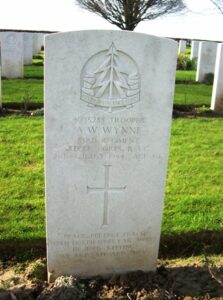Carmarthen is the County Town of Carmarthenshire, and is the second largest town in the county, after Llanelli. The men of Carmarthen who fell during World War Two are commemorated on the County War Memorial, which is located at Priory Street. There are no names on the memorial, so the men and women commemorated on this page are all of the ones that I can identify as being from the town. Apologies for any omissions, it is not intentional. It is easy for me to add extra details, and I will do as more information surfaces.
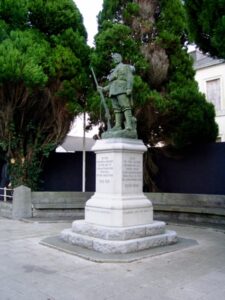
Carmarthen War Memorial, World War Two, 1939-1945
John Edward Wilberforce Arthur, Wing Commander, 87084, Royal Air Force Volunteer Reserve. John was born in 1906, the son of Arthur Arthur and Hannah Jane Arthur (nee Davies), of Penrhos, Carway View, Carmarthen. He enlisted into the Royal Air Force Volunteer Reserve and was commissioned from Leading Aircraftman to Flight Lieutenant on 3 July 1940, joining the Balloon Branch. John was later promoted to Wing Commander and became attached to the HQ of the NWAAF, in Tunis. John died as a result of a vehicle accident in North Africa on 29 September 1943. The 37-year-old was originally buried in La Borgel Civil Cemetery in Tunis, but in August 1944 the military graves within the cemetery were relocated into Medjez-El-Bab War Cemetery, Tunisia.
Archie Winston Arundel, Flight Sergeant, 964173, Royal Air Force Volunteer Reserve. Archie was born on 11 November 1913, the son of Phillip John Arundel and Ellen Arundel (nee Evans), of Pentrefelin, Carmarthen. He married Violet Marcel Northam in 1938 and the couple set up home at 18, Bridge Street, Carmarthen. Archie enlisted into the Royal Air Force Volunteer Reserve soon after the outbreak of war and was posted to 2742 Squadron, Royal Air Force, which was an Armoured Cars unit. The unit landed at Gold Beach on D-Day plus 22, 28 June 1944, for airfield defence duties. Archie died in France on 5 March 1945. The 31-year-old was originally buried in Andilly American Cemetery, but in February 1947 the British war graves within the cemetery were exhumed and relocated into Choloy War Cemetery, France. His brother Ivor also fell.
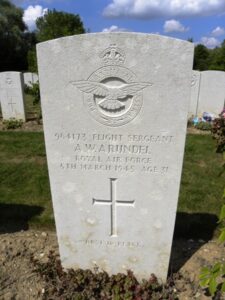
Ivor Arthur Arundel, Private, 3961939, Welch Regiment. Ivor was born on 6 May 1917, the son of Phillip John Arundel and Ellen Arundel (nee Evans), of Pentrefelin, Carmarthen. He served with the 16th (HD) Battalion, Welch Regiment. Ivor died on active service at Cardiff on 25 June 1940. The remains of the 23-year-old were conveyed home and he was buried in Carmarthen (Tabernacle) Baptist Chapelyard, Wales. His brother Archie also fell.
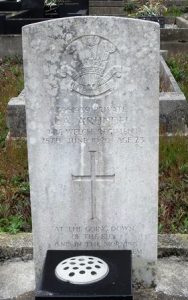
Joseph Anthony Barnett, Corporal, 3971518, Devonshire Regiment. Joseph was born on 7 January 1913, the son of Thomas Barnett and Catherine Barnett (nee Hurley), of Carmarthen. He worked as a Grocery Store Manager prior to the war and married Elizabeth Annie Luton in Carmarthen in 1941. Joseph enlisted into the army and was posted to the Far East to join the 1st Battalion, Devonshire Regiment, which was in India, attached to the 80th Indian Infantry Brigade, 20th Indian Infantry Division. Joseph died in India whilst on active service, on 3 August 1944. The 31-year-old was buried in Imphal War Cemetery, India. He is also commemorated on a memorial at Carmarthen Cemetery.
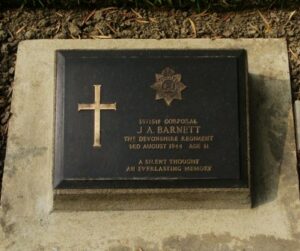
William James Bennett, Civilian. William was born at Gloucester in 1883, the son of James Bennett and Elizabeth Bennett. The family had moved to 8, Sydney Street, Brynhyfryd, Swansea by 1911, and William worked as a Horse Driver. Whan the Second World War erupted, William was living at 98, Townhill Road, Mayhill, Swansea, and volunteered to become a Firewatcher. He was injured at Townhill Road during a German air raid on Swansea on 20 February 1941, and died at Carmarthen infirmary on 28 February 1941, aged 58. William’s remains were buried in St. Luke’s Cemetery at Swansea on 5 March.
William Donald Bowen, Sergeant (Flight Engineer), 1378175, Royal Air Force Volunteer Reserve. William was born in 1916, the son of Thomas Benjamin Bowen and Mary Bowen (nee Morgan), of Carmarthen. He married Beryl Williams, of 5, Mansel Street, Carmarthen, in 1941. William enlisted into the Royal Air Force Volunteer Reserve and after completing his training as a Flight Engineer was posted to 15 Squadron, Royal Air Force, which was a heavy bomber squadron, armed with the Short Stirling III, based at RAF Bourn. On the night of 1 March 1943, William took off from Bourn as part of the crew of Stirling W7518. At around 01.00 the following morning, the Halifax was intercepted by a German FW night fighter, and was shot down above the Oosterschelde. Of the crew of seven, only one man escaped. William and five of his crewmates died in the crash on the morning of 2 March 1943, and are buried together at Bergen-Op-Zoom War Cemetery, Netherlands. William was 27 years old.
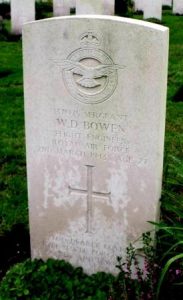
Bertie John Brock, Lance Corporal, T/14409040, Royal Army Service Corps. Bertie was born in 1915, the son of George John Brock and Ella Mabel Brock (nee Dunn), of Merton Park, Surrey. He enlisted into the army and was posted to the Royal Army Service Corps. Bertie was injured in an accident and died at Carmarthen Infirmary on 5 June 1945. The 20-year-old was buried in Carmarthen Cemetery.
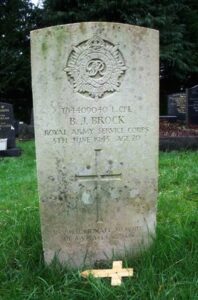
Arthur Sidney Buckland, Private, 4036619, Durham Light Infantry. Arthur was born on 29 November 1919, the son of Herbert Horace Buckland and Elizabeth Ann Buckland (nee Morgan), of Hereford. He worked as a gardeners assistant prior to enlisting into the army and was posted to the 10th Battalion, Durham Light Infantry, which was attached to the 49th (West Riding) Infantry Division. Arthur married Arianwen Phillips, of 81, Priory Street, Carmarthen, whilst home on leave in 1944, then rejoined his battalion in time to take part in the Normandy Landings. The division landed on Normandy after D-Day, on 13 June 1944 and took part in the attempts to capture Caen. Arthur was killed in Normandy on 11 September 1944. The 23-year-old was buried in Ryes War Cemetery, Bazenville, France.
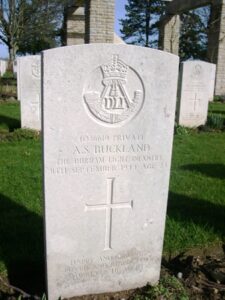
Betty Maud Burgess, Nurse. Betty was born in Exeter on 18 February 1922, the daughter of Frederick James Burgess and Florence Mary Burgess (nee Hooper). Her father worked for the Great Western Railway, and moved the family to Whitland, where he had gained the position of Station Master. Her mother died soon afterwards and in 1931 his father married a widow, Ellen Edwards (nee James), of Llanfallteg. By 1939 the family was residing at Tynewydd Road, Carmarthen, and Frederick had become Station Master at Carmarthen Railway Station. Betty left home after the outbreak of war to become a nurse and worked in Biggleswade. She contracted diphtheria during her work as a Nurse and died at the Three Counties Emergency Hospital, Stotford on 26 November 1944. The remains of the 22-year-old were conveyed home to Carmarthen and she was buried in St. Cynwyr’s Churchyard, Llangunnor on 1 December. Betty is not commemorated as a casualty of war by the CWGC, but she is commemorated on the Llangunnor War Memorial.
James Patrick Burns, Sergeant, 3956118, Royal Armoured Corps. James was born in 1911, the son of Sergeant James Joseph Burns, of the Welsh Regiment, and Marie Elizabeth Jane Burns (nee Mark), of Carmarthen Barracks. He married Eileen May Merrifield, of Cardiff, in the summer of 1939. James enlisted into the army and was posted to the 3rd Royal Tank Regiment, Royal Armoured Corps. The regiment moved to the Middle East in 1941, and then as part of the 1st Armoured Brigade moved to Greece. The 3rd Royal Tank Regiment withdrew to North Africa after the fall of Greece, to serve with the 7th Armoured Division. James was killed in action just weeks before the 1st Battle of El Alamein, on 7 June 1942. The 31-year-old was originally buried in an isolated grave in Cyrenaica, but in June 1944 his grave was exhumed and he was re-interred in Knightsbridge War Cemetery, Acroma, Libya.
Daniel Eric Butters, Leading Aircraftman, Royal Air Force. Daniel was born in 1920, the son of Alfred John Butters and Mary Jane Butters (nee Williams), of 12, St. John Street, Carmarthen. He enlisted into the Royal Air Force, and was sent to Canada under the Empire Air Training Scheme, for further training. Daniel met, and married, Marion Jean Campbell, of Detroit, at Wayne, Michigan, and they had a son, Michael, born in 1943. Daniel contracted cancer, and was repatriated home, but sadly died in Carmarthen in 1944, aged 24. Daniel is not commemorated by the CWGC, so nothing further is known of him.
Philip Jarvie Carnie, Master, Merchant Navy. Philip was born in Newhaven, Leith, Scotland on 18 April 1897, the son of Thomas Cowan Carnie and Jane Carnie (nee Jarvie). He married Annie Etheridge in Leith, Edinburgh on 16 May 1921. Philip was a long serving Merchant Seaman, and when war broke out was granted command of the Ardrossan registered cargo steamer, S.S. Baron Semple. On 2 November 1943 she was on route from Rio de Janeiro for Freetown, with a cargo of iron ore, when she was torpedoed by the German submarine U-848 off Ascension Island, and sank with the loss of all hands. Philip was 46 years old when he died that day, and is commemorated on the Tower Hill Memorial, London. His widow, Annie, was residing in Carmarthen when Philip was killed, but later returned to Edinburgh where she died in 1987.
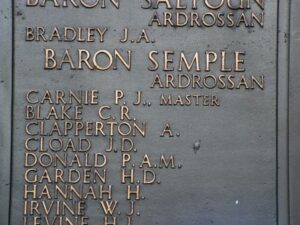
Edgar Roy Carruthers, Flight Lieutenant (Pilot), 155753, Royal Air Force Volunteer Reserve. Edgar was born on 15 March 1921, the son of Christopher Carruthers and Hannah Jane Carruthers (nee Hughes), of 21, Bridge Street, Carmarthen. He worked as a Civil Servant in Cardiff prior to enlisting into the Royal Air Force Volunteer Reserve and trained as a pilot before being gazetted as Flight Sergeant in November 1943. He was then posted to 609 Squadron, Royal Air Force, which was an RAF Fighter Command unit, equipped with the Supermarine Spitfire, based at RAF Duxford. In the summer of 1942 the squadron re-equipped with Hawker Typhoon IB’s, to counter the Luftwaffe’s Focke-Wulf Fw 190 fighter, and was very successful. During the opening months of 1944 the Squadron was involved with the destruction of German Radar Stations along the French Coast, prior to the Normandy Landings, then took part in air strikes on vital targets in occupied Europe. After the end of the war, the Squadron remained in Germany, based at RAF Wunstorf. Edgar was killed when he flew his Hawker Typhoon IB into the ground whilst descending through low cloud on 8 August 1945. The 24-year-old was buried in Becklingen War Cemetery, Germany.
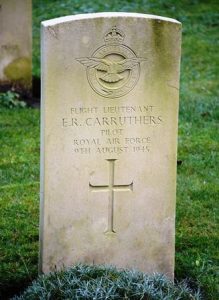
Frederick Thomas Chamberlain, Captain, 75818, Royal Electrical and Mechanical Engineers. Frederick was born in Halifax, Nova Scotia in 1903, the son Harry and Frances Mary Chamberlain. He married Florence Elizabeth Jones, of Carmarthen, in Farnham, Surrey in 1932, and the couple settled at 17, Priory Street, Carmarthen. Frederick had served throughout the war with the Royal Electrical and Mechanical Engineers, enlisting as a Private, and rising to the rank of Captain by the Armistice. He survived the war but died in hospital in York on 7 December 1946. The remains of the 43-year-old were conveyed back home and he was buried in Carmarthen Cemetery.
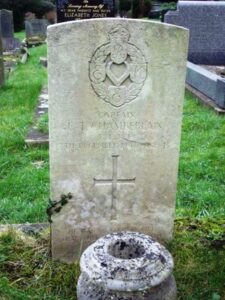
Ernest Francis Lewis Collins, Flight Sergeant, 967795, Royal Air Force Volunteer Reserve. Ernest was born in Swansea in 1918, the son of Ernest Frederick Coates Collins and Frances Jane Collins (nee Lewis). The family moved to his mothers native Carmarthen soon after Ernest’s birth. Ernest enlisted into the Royal Air Force Volunteer Reserve and after completing his training was posted to 106 Squadron, Royal Air Force, a Bomber Command unit, based at RAF Metheringham, Lincolnshire. On the night of 29/30 August 1944 Ernest took off from Metheringham aboard an Avro Lancaster III, Serial JB593 ZN-T. The Lancaster was intercepted and shot down in the Konigsberg area of Germany during the early hours of 30 August 1944, killing all the crew. Ernest was 26 years old when he was killed that morning and is commemorated alongside his fellow crewmen on the Runnymede Memorial, Surrey. A memorial has recently been unveiled at Metheringham to commemorate the crew of Lancaster JB593 ZN-T: Group Captain William McKechnie, Sergeant Robert Barclay Clarke, Flight Sergeant Henry William Tilson Carter, Sergeant Charles Colin Jeffrey, Sergeant Douglas Forster and Flight Sergeant Ernest Lewis Collins. (Many thanks to Marita Aitken for initially identifying Ernest).

John William Congreve, Lieutenant, Royal Naval Volunteer Reserve. John was born on 12 August 1912, the son of Major Claude Vyvian Congreve, of the Indian Army, and Mary Hudson Congreve (nee Titley), of Island House, Laugharne. The family had originally born the surname Schneider, until the advent of WW1, when Claude changed it to Congreve. John lived at 6, The Esplanade, Carmarthen prior to enlisting into the Royal Naval Volunteer Reserve (London Division) on 22 January 1937. He was promoted to Temporary Sub Lieutenant on 28 September 1939 and posted to HMS Rhodora, an armed yacht. On 15 August 1940 John was made a full Lieutenant and posted to the destroyer HMS Tynedale, a newly built ‘Hunt’ class destroyer. Tynedale’s most famous action was during ‘Operation Chariot’ on the night of 28 March 1942, an ambitious plan hatched by the British Combined Operations to disable the Normandie dry dock at St. Nazaire on the French coast. HMS Tynedale was part of the escort to the old American destroyer HMS Campbelltown, which was used to smash into the gates of the massive dry docks, and was exploded there, putting the dock out of action for the rest of the war, and thus prevented the Germans from bringing their massive Battleship, Tirpitz into the port. Tynedale was later despatched to the Mediterranean. She was escorting a convoy off the coast of Algeria on 12 December 1943 when she was spotted and torpedoed by the German submarine U-593. John died that day, as a result of the torpedo explosion, at the age of 31. He has no known grave and is commemorated on the Plymouth Naval Memorial, Devon.
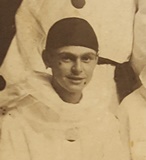
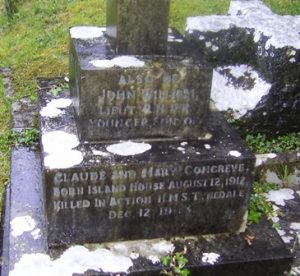
Wilfred Herbert Currier, Sergeant (Wireless Operator/Air Gunner), 1316120, Royal Air Force Volunteer Reserve. Wilfred was born on 15 June 1921, the son of Herbert George Currier and Alice Currier (nee Stafford), of 20, Bridge Street, Carmarthen. He worked as a Printer’s Apprentice prior to the war, then enlisted into the Royal Air Force Volunteer Reserve, and after completing his training as a Wireless Operator/ Air Gunner was posted to 115 Squadron, Royal Air Force, a heavy bomber squadron, equipped with the Avro Lancaster II, based at RAF Little Snoring. On the night of 18 October 1943, Wilfred took off from Little Snoring aboard an Avro Lancaster II, Serial DS769, which joined a force of some 360 aircraft despatched to strike targets in Hanover. The aircraft of the Pathfinder Force were unable to mark the targets due to cloud cover, and the raid, the last on Hanover, was a failure. Wilfred was killed when his Lancaster was shot down over Germany during the raid, on 18 October 1943. The remains of the 22-year-old, together with three fellow crewmen, were recovered from the wreckage of the Lancaster and buried in Altenberge Communal Cemetery as unknown airmen. In May 1947 the graves were exhumed and identified, before being re-interred in Reichswald Forest War Cemetery, Germany.
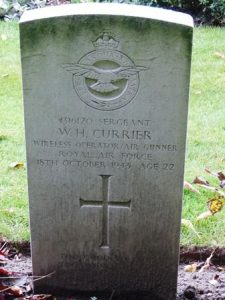
Thomas William Reynold Daniel, Sergeant, 1315951, Royal Air Force Volunteer Reserve. Thomas was born in 1921, the son of William Henry Daniel and Margaret Emily Daniel (nee Davies), of Carmarthen. He enlisted into the Royal Air Force Volunteer Reserve and after completing his training as an Air Gunner was posted to 78 Squadron, Royal Air Force, a Heavy Bomber unit, which was equipped with the Handley Page Halifax, based at RAF Breighton. On the night of 11 June 1943, Thomas took off from Breighton aboard a Handley Page Halifax II, Serial W7932, which joined a force of some 783 aircraft despatched to strike targets in Düsseldorf. Severe damage was caused to the centre of Düsseldorf with at least 130 acres laid waste and almost 1,300 people killed, whilst eight ships were damaged. Thomas was killed on the return journey, when his Halifax was intercepted by a German night fighter and shot down and crashed some two miles west of Sambeek, Holland, on the morning of 12 June 1943. Thomas was 21 years old when he was killed that morning and was buried alongside his six fellow crewmen in Eindhoven (Woensel) General Cemetery, Netherlands.
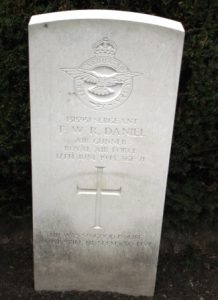
Alan Scourfield Davies, Stoker, D/KX 118076, Royal Navy. Alan was born on 5 July 1921, the son of David John Davies and Catherine Jane Davies (nee Phillips), of Carmarthen. He served as a stoker aboard the Leander-class light cruiser HMS Neptune. She took part in the hunt for the battleship Graf Spee during the early months of the war and was en-route to Uruguay when the Germans scuttled Graf Spee off Montevideo on 17 December 1939. She was then despatched to the Mediterranean and took part in the action against the Italian Fleet in the battle of Calabria, on 9 July 1940, where she was hit by a 6 inch shell. During 1941 she led Force K, a raiding squadron of cruisers tasked with destroying German and Italian convoys en route to Libya. On 18 December 1941 Force K was sent out to intercept a convoy bound for Tripoli. On the night of 19 – 20 December, Neptune struck two mines. While reversing out of the minefield she struck another mine which blew off her propellers. Two other cruisers also struck mines and were unable to help, so two destroyers were sent in to tow Neptune out. The leading destroyer also struck a mine, so the captain of Neptune signalled the second to stay clear. Soon after Neptune drifted into a fourth mine which caused her to capsize and sink, going down with the loss of 737 men. Thirty men survived but only one was rescued alive. Alan was among the dead. He was 20 years old and is commemorated on the Plymouth Naval Memorial.
Alun Meilir Davies, Private, 14635646, Parachute Regiment. Alun was born on 27 July 1924, the son of William Davies and Martha Davies (nee Jones), of Carmarthen, and was educated at Carmarthen Grammar School. His parents later moved to Aberystwyth. Alun enlisted into the army and became selected for the Special Forces, joining the 9th Battalion, Parachute Regiment, Army Air Corps. The battalion had formed in November 1942 from the 10th Battalion, Essex Regiment, and was assigned to the 3rd Parachute Brigade, which was initially attached to the 1st Airborne Division. In April 1943 the 1st Airborne Division left Britain to take part in the Allied invasion of Sicily, leaving the 3rd Parachute Brigade behind, then on 23 April the brigade became transferred to the newly formed 6th Airborne Division. At dawn on 6 June 1944, D-Day, the 9th Parachute Regiment left England, tasked with the capture of the famous Merville Gun Battery in Normandy, and landed around the area in gliders during the early hours of D-Day, 6 June 1944. Alun was killed during the capture of the battery that day. The 19-year-old was posted as missing, but was later deemed to have been killed in action. He has no known grave, so is commemorated on the Bayeux Memorial, France.
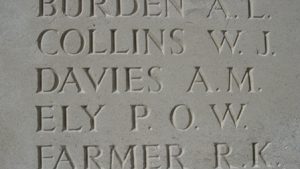
Arthur James Davies, Private, 3963477, Welch Regiment. Arthur was born on 16 August 1920, the son of Watkyn Davies and Margaret Davies (nee Evans), of Carmarthen. He married Margaret Avril Morris, of Porthcawl, on 25 May 1942, probably whilst serving there with the 15th Battalion, Welch Regiment. He subsequently transferred to the 4th Battalion, Welch Regiment, which was the Carmarthenshire Territorial battalion, attached to the 53rd (Welsh) Division. The division landed in Normandy during the end of June 1944 and took over the line at Grainville-sur-Odon. During the coming weeks the division took part in heavy fighting during the break-out from Normandy and the subsequent drive north through France and Belgium into Holland, taking part in Operation Market Garden. Arthur was seriously wounded towards the end of the taking of the Dutch town of S’Hertogenbosch on 23 October 1944, and died of his wounds on the following day, 24 October 1944. The 24-year-old was originally buried in the town, but in May 1946 the scattered war graves in the area were exhumed and re-interred in Uden War Cemetery, Netherlands.
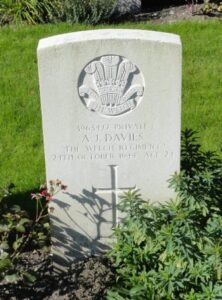
David Davies, Gunner, 1747527, Royal Artillery. David was born in 1907, the son of Albert Davies and Sarah Jane Davies (nee Harris), of Carmarthen. He had married prior to the war and lived with his wife Elizabeth Davies, at Carmarthen. David enlisted into the Royal Artillery, and was posted to A/223 Heavy Anti-Aircraft Training Regiment. Little else is presently known of him, but he died on active service, possibly in the Bridgend area, on 25 February 1941. The remains of the 33-year-old were brought home and he was buried in Carmarthen (Tabernacle) Baptist Chapelyard.
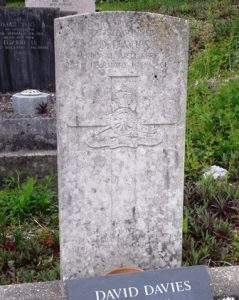
Douglas Thomas Davies, Lance Corporal, 2734786, Welsh Guards. Douglas was born in 1920, the son of Victor Henton Davies and Elizabeth Davies, of 58 Priory Street, Carmarthen. He enlisted into the army and was posted to the 2nd Armoured Battalion, Welsh Guards, which was attached to the Guards Armoured Division. Between 18 to 29 June 1944 the battalion landed in Normandy, and took part in the break out from the Normandy Beach-Head. It then took part in the infamous fighting in the Bocage, before heading towards Holland, with the Guards Armoured Division, and taking part in Operation Market Garden. Douglas was badly wounded after the crossing of the Rhine, and died of his wounds on 9 April 1945. The 24-year-old was buried in Oldenzaal Protestant Cemetery, Overijssel, Netherlands.
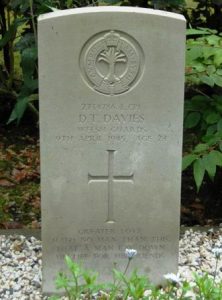
Edward David Davies, Lance Corporal, 3962412, Monmouthshire Regiment. Edward was born in 1915, the son of Evan Tom Davies and Mary Ann Davies (nee Edwards), of Carmarthen. He married Sarah Nancy Ellis, of Carmarthen, in 1937. Edward originally enlisted into the Welch Regiment, but was later transferred into the 3rd Battalion, Monmouthshire Regiment. The battalion, a Territorial Army unit, was mobilised for war as part of the 53rd (Welsh) Division and moved to Northern Ireland to begin garrison duties. The Division then moved to Pembroke Dock, before moving again to the south of England, where it trained in readiness for the D-Day Landings. In the summer of 1942, the 3rd Monmouth’s transferred to the 11th Armoured Division and began training as a mechanised unit, equipped with Valentine and Crusader tanks. Most of the 11th Armoured Division landed on Juno Beach on 13 June 1944 and saw its first major action during Operation Epsom on 26 June, where it assisted the 15th (Scottish) Division alongside the 159th Brigade, which had been attached to it from the 53rd (Welsh) Division. The division then took part in the break-out from Normandy, and the subsequent drive through France into Belgium and Holland, during Operation Market Garden. Edward was killed in Holland on 17 October 1944. The 29-year-old was originally buried in an isolated grave in Venray, but in August 1946 his grave was exhumed and he was re-interred in Venray War Cemetery, Limburg, Netherlands.
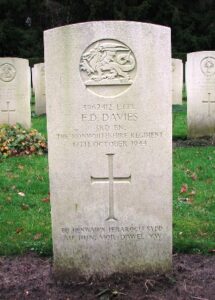
Glyndwr Davies, Gunner, 1691913, Royal Artillery. Glyndwr was born on 14 October 1912, the son of Henry James Davies and Elizabeth Davies (nee Griffiths), of 62, Richmond Terrace, Carmarthen. He was lodging with his elder sister Mary and her family at Eastry in Kent prior to enlisting into the Royal Artillery soon after the outbreak of war and was posted to 521 Battery, 85 Searchlight Regiment, Royal Artillery. The battery was formed to help protect airfields in the south west of England. Glyndwr was 28 years old when he died as the result of an accident whilst on active service near Oxford on 17 August 1941. The remains of the 28-year-old were brought home, and he was buried in Carmarthen Cemetery. His sister Mary, her husband, John Henry James, and their youngest daughter, Margaret, were all killed in an air raid in 1941.
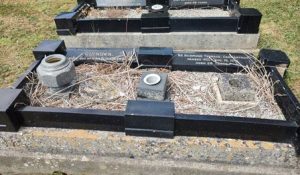
James Glyn Davies, Flying Officer, 175652, Royal Air Force Volunteer Reserve. James was born in 1913, the son of Thomas Davies and Mary Davies (nee Lewis), of Carmarthen. He married Hannah May Daniel, of Bronwydd, in 1941. James enlisted into the Royal Air Force Volunteer Reserve and after completing his training as a pilot was posted to 166 Squadron, Royal Air Force, which was a heavy bomber unit, equipped with the Avro Lancaster III, based at RAF Kirmington. On the night of 23 September 1944, James took off from Kirmington, flying an Avro Lancaster III, Serial LM722, which joined a bomber group despatched to strike targets in Neuss. James was killed when his Lancaster was lost without trace on the following morning, 24 September 1944, with its entire crew of seven men. The 31-year-old is commemorated on the Runnymede Memorial, Surrey.
James William Elias Davies, DFC, Flight Sergeant, 37796, Royal Air Force. James, known as Jimmy, was born in America in 1914, the son of David Ashley Davies and Catherine Isabella Davies (nee Elias). His parents were both Welsh, and after the end of the Great War, settling at Towy Villa, Cwmoernant, Carmarthen. James joined the Royal Air Force in 1936, and by the outbreak of war was a fighter pilot with 79 Squadron, which was equipped with the Hawker Hurricane I, based at RAF Biggin Hill in Kent. The squadron was soon in action and by the end of June 1940 Davies had already claimed six German aircraft, with two shared claims. On 27 June 1940 he was due to be presented with the Distinguished Flying Cross from the King when he was sent as an escort to protect six aircraft on a reconnaissance mission to the French port of St Valery. Jimmy was piloting one of three Hurricanes on the flight, when they were attacked by three Messerschmitt Bf109s over the English Channel. One of the Hurricanes escaped, but Jimmy and one other were shot down into the sea, the other one pilot bailing out safely. Jimmy became the first American born pilot to be shot down and killed in World War Two. He was 26 years old. His Distinguished Flying Cross, which he didn’t see himself, was awarded for ‘This officer has shown ability as a leader of his squadron on many offensive patrols. On one occasion while attacking a Messerschmitt 109, he was himself attacked by six Heinkel 113’s. He at once turned on the Heinkels destroying one and badly damaging a second before being compelled to break off the engagement owing to shortage of ammunition. The following day he sighted and attacked a large formation of Heinkel 111’s and shot one down in flames.’ He had also been Mentioned in Despatches for his gallant conduct.
John Davies, M.D., M.R.C.P., Commander Surgeon, Royal Naval Volunteer Reserve. John was born on 24 September 1898, the son of Moses Davies and Margaret Davies, of Carmarthen. After leaving Carmarthen Grammar School he studied to become a Doctor and after marrying Elizabeth Gwladys Davies on 23 June 1932, the couple settled at 308, Finchley Road, Hampstead, London. John had served as a Surgeon with the Royal Naval Volunteer Reserve during both World Wars, with the rank of Commander Surgeon, and during World War Two was based at HMS Drake. John died of heart disease in Hampstead on 2 August 1945. The 47-year-old was buried in Hampstead Cemetery, England.
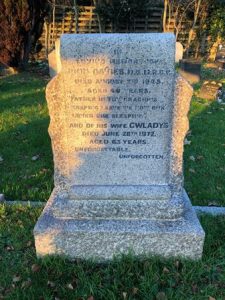
John Derrick Edwards Davies, Pilot Officer (Air Gunner), 176215, Royal Air Force Volunteer Reserve. John was born on 23 December 1922, the son of Daniel Edwards Davies and Katherine Davies (nee Jones), of Carmarthen, and was baptised at St. David’s Church. His father worked as a Bank Clerk for the National Provincial Bank, and by 1939 the family had moved to Whitchurch, Shropshire. John was a student when war broke out, and left his studies to enlist into the Royal Air Force Volunteer Reserve. After training as an Air Gunner he was posted to 180 Squadron, Royal Air Force, which was equipped with the North American Mitchell II, based at RAF Dunsfold. On 15 June 1944 John was taking part in a raid on a Panzer HQ in France, supporting the Normandy landings, when the aircraft was hit by Flak and he was killed. The damaged aircraft landed safely and the rest of the crew survived. The 21-year-old was buried in Brookwood Military Cemetery, Surrey.
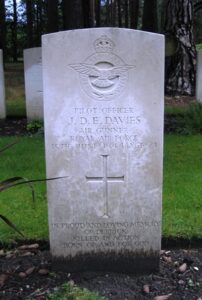
Oliver Geoffrey Davies, Flight Sergeant, 972287, Royal Air Force Volunteer Reserve. Oliver was born on 18 April 1920, the son of John Joseph Davies and Kate Marion Davies (nee Hughes), of 8, Lime Grove Avenue, Carmarthen. He worked as an Insurance Agent prior to enlisting into the Royal Air Force Volunteer Reserve, and after completing his training as a Wireless Operator/ Air Gunner was posted to 612 Squadron, Royal Air Force, which was equipped with the Vickers Wellington VIII, and the Armstrong Whitworth Whitley VII, based at RAF Wick, Caithness, on an anti-submarine role. On 9 November 1942, Oliver was flying aboard an Armstrong Whitworth Whitley VII, searching for a Vickers Wellington I of 179 Squadron which had gone missing in bad weather. In thick mist, the Whitley crashed into a hill on the Faroe Islands, killing all five men aboard. Oliver was 22 years old when he was killed that day and was buried alongside his fellow crewmen in Midvaag Military Cemetery, Faroe Islands.
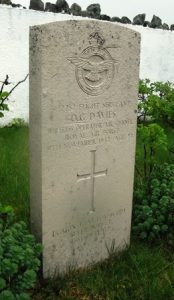
Thomas Anthony Frederick Davies, Sergeant, Royal Air Force Volunteer Reserve. Thomas, known as Tony by his family, was the son of James and Mary Ellen Davies, of Carmarthen. He enlisted into the Royal Air Force Volunteer Reserve, and after completing his training as a Navigator, was posted to 158 Squadron, Royal Air Force, which was equipped with the Vickers Wellington II, based at RAF Driffield. On the night of 10 April 1942, Tony took off from Driffield aboard a Vickers Wellington II, Serial W5482, on a Nickel Raid over Lille. These raids took place at the end of a crews training programme, when it was felt that they had reached a certain level of proficiency and were ready for bombing duties and involved the dropping of propaganda leaflets, which were designed to undermine the occupying German forces and to boost the morale of the local inhabitants. Sadly these raids were also very dangerous and many losses were suffered through them. Tony was killed when his Wellington was lost, believed to have crashed into the sea off Oostende, on the following morning of 11 April 1943, with all five of her crew. Thomas was 21 years old when he died that morning. He has no known grave, so is commemorated on the Runnymede Memorial, Surrey. He is also commemorated on his parents grave in St. Mary’s Churchyard, Carmarthen.
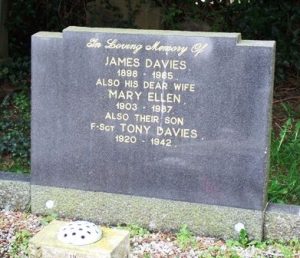
George Francis Done, Sergeant (Navigator), 1338185, Royal Air Force Volunteer Reserve. George was born in 1921, the son of George Done and Margaret Done (nee Curzon), of 4, Royle Street, Northwich. He had gained his Teachers Diploma at Trinity College, Carmarthen prior to enlisting into the Royal Air Force Volunteer Reserve and after completing his training as a Navigator, was posted to 9 Squadron, Royal Air Force, which was equipped with the Avro Lancaster I, based at RAF Waddington. On 31 January 1943 George was flying as Navigator aboard an Avro Lancaster III, Serial ED481, which was returning home after a successful raid on Hamburg. The Lancaster was diverted to RAF Leeming, but crashed into Hawnby Hill in the North Yorkshire Moors, killing all the crew. George was 21 years old, and was buried in Northwich Cemetery, England.
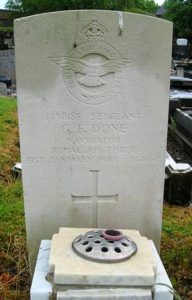
Frank Gerald Edwards, Corporal, 321290, Royal Armoured Corps. Frank was born in 1916, the son of Rhys Caradoc Edwards, and of Gertrude Edwards (nee Davies), of 117, Priory Street, Carmarthen. He enlisted into the army and was posted to the 15th/19th The King’s Royal Hussars, Royal Armoured Corps. The unit was the divisional reconnaissance regiment of the 11th Armoured Division, and landed on Juno Beach in Normandy on 13 June 1944, seven days after D-Day. The division then took part in all of the major operations of the British Second Army in Normandy, including Operations Epsom, Goodwood, and Bluecoat, and the battles around the Falaise Gap. After the cancellation of Operation Goodwood due to its failure, the division was withdrawn on 20 July to rest and refit before taking part in Operation Bluecoat, which opened on 30 July 1944. The division successfully broke the German lines, liberating Saint-Martin-des-Besaces, before crossing the Souleuvre river, then liberated Le Bény-Bocage on 1 August before continuing to drive southward. On 5 August the division was hit by a counter-attack, led by the 9th SS Panzer Division, which was defeated before the division was transferred to XXX Corps, and took part in the drive to destroy the now retreating Germans. Frank was killed in Normandy on 19 August 1944, two days after the division liberated Flers. The 28-year-old was originally buried at Argentan, but in August 1946 the scattered graves in the area were exhumed and re-interred in Banneville-La-Campagne War Cemetery, France.
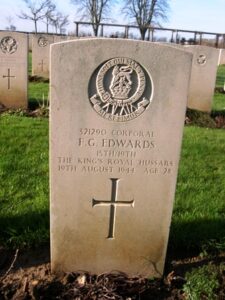
Benjamin Kenneth Hall Evans, Sergeant (Flight Engineer), 1031846, Royal Air Force Volunteer Reserve. Benjamin was born on 19 December 1922. His father must have died when he was young and later became Mrs. Jones, of The Old Bull, Guildhall Square, Carmarthen. He enlisted into the Royal Air Force Volunteer Reserve and after completing his training as a Flight Engineer was posted to 467 (RAAF) Squadron, Royal Air Force, a mainly Australian unit, equipped with the Avro Lancaster I, based at RAF Bottesford. On the night of 12 July 1943, Benjamin took off from Bottesford aboard an Avro Lancaster III, Serial ED531, which joined a large force of bombers despatched to strike targets in Germany. Unfortunately, due to heavy winds, his Lancaster strayed into Swiss airspace and was hit by Swiss anti-aircraft fire. The aircraft jettisoned its bomb load, but became trapped in a valley in a thunderstorm, and flew into high ground at Thyon-les-Collons, killing all seven men aboard. Benjamin was 20 years old when he was killed that night and was buried besides his fellow crewmen in Vevey (St. Martins) Cemetery, Switzerland.
Douglas Henry Evans, Private, Home Guard. Douglas was born at Lampeter on 11 February 1926, the son of Annie Amelia Critchley. His mother later married David Evans and Douglas was raised as his son. Douglas was living at Tudorville, Llangunnor with his grandmother when war broke out, and being too young for the army, joined the Home Guard. He was then posted to the 44th Warwickshire (Birmingham) Battalion, Home Guard and lodged at 21, Sycamore Road, Handsworth, Birmingham. Douglas died in Birmingham on 14 August 1943. The remains of the 17-year-old were brought home, and he was buried in St. Cynwyr’s Churchyard, Llangunnor. The photograph is courtesy of Bev Lewis.
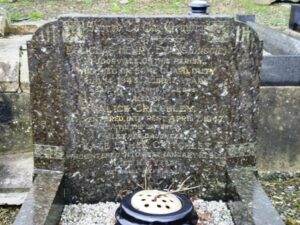
Henry Gwyn Evans, Sapper, 2045238, Royal Engineers. Henry was born on 11 April 1913, the son of William Evans and Sarah Jane Evans (nee Robbins), of 4, Spring Gardens, Carmarthen. He married Irene Jay in 1932, and the couple resided at Llantwit Major, Glamorgan. Henry was a member of the Territorial Army and had served with the Welsh Field Company, Royal Engineers for several years prior to the war. Upon being mobilised he was posted to the 580 Army Troops Company, Royal Engineers. Henry’s unit was in Greece in 1941 when the Germans invaded and retreated through the Servian Pass, demolishing bridges and crossings as the Allied Forces in Greece withdrew in front of the advancing German troops. Henry was posted as missing at sometime between 20 and 23 April 1941, during the evacuation of Greece and was later deemed to have been killed in action between those dates. The 28-year-old has no known grave and is commemorated on Face 4 of the Athens Memorial, Greece. His father, also a member of the Welsh Field Company, Royal Engineers, had died in World War 1.
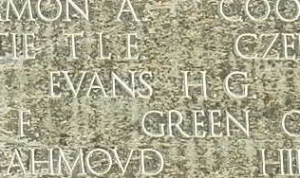
John Evans, B.A., B.M., B.Ch., (Oxon), Lieutenant, 328024, Royal Army Medical Corps. John was born on 7 August 1920, the son of Herbert John Evans and Eveline Maye Evans, of 10, Penllwyn Park, Carmarthen. He was educated at Liverpool and at Oxford University, studying medicine and graduated BA, BM, and BCh. John was then commissioned into the Royal Army Medical Corps and was posted to the Far East, to India. John became ill in India, and died at Poona Military Hospital on 20 July 1945, aged 24. He is buried in Kirkee War Cemetery, India.
Mair Eluned Evans, Sister, 234957, Queen Alexandra’s Imperial Military Nursing Service. Mair was born in 1915, the daughter of Benjamin Evans and Mary Morfydd Evans (nee Thomas), of Pantyryn, Llangunnor. She worked as a Nurse at Carmarthen Hospital prior to the war, then volunteered to serve as a Nurse with Queen Alexandra’s Imperial Military Nursing Service. On 23 November 1942 Mair sailed from Liverpool aboard the S.S. Ceramic, a requisitioned former White Star Liner, which was bound for Australia. On the night of 6 December 1942 she was west of the Azores when she was hit by three torpedoes which had been fired from the German submarine U-515. Lifeboats were launched, but U-515 torpedoed her again, sinking Ceramic. The sea conditions were stormy, and the lifeboats capsized. Only one man survived the sinking, as he was taken by the Germans for interrogation. Mair was 27 years old when she died on 7 December 1942, and she is commemorated on the Brookwood Memorial, Surrey.
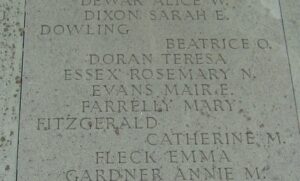
Walter Picton Evans, Corporal, 7382463, Royal Army Medical Corps. Walter was born on 28 April 1913, the son of Evan Walter Evans and Elizabeth Evans (nee Rees), of 3, Nott Square, Carmarthen. He was educated at Carmarthen Grammar School and at Llandovery College, prior to becoming a bank clerk in London, and by the time war erupted was residing at Clifton Gardens, Paddington. Walter enlisted into the army soon after and was posted to the Royal Army Medical Corps. He died as a result of an accident at Cirencester on 14 March 1943. The remains of the 29-year-old were brought home, and he was buried in Carmarthen Cemetery.
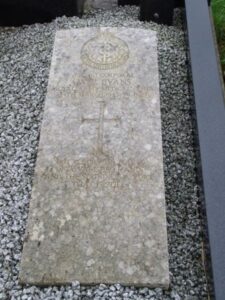
William David Evans, Sergeant, 1005138, Royal Air Force Volunteer Reserve. William was born on 9 October 1915, the son of Robert Evans and Margaret Ann Evans, of 4, Friars Row, Carmarthen. He worked as a Printer’s Compositor prior to enlisting into the Royal Air Force Volunteer Reserve and after completing his training as a Navigator, was posted to 9 Squadron, Royal Air Force, which was a heavy bomber squadron, equipped with the Avro Lancaster I, based at RAF Waddington. On the night of 30 August 1943, William took off from Woodhall Spa aboard an Avro Lancaster III, Serial ED551, which joined a large bomber force despatched to strike targets in Monchengladbach. William was killed when his Lancaster was lost without a trace with all her crew on the following morning of 31 August 1943. The 27-year-old has no known grave, so is commemorated on the Runnymede Memorial, Surrey.
Robert Furlong, Gunner, 1493232, Royal Artillery. Robert was born on 16 April 1919, the son of John Furlong and Ivy Amanda Furlong (nee Rogers), of Spilman Street, Carmarthen. He enlisted into the army soon after the outbreak of war and embarked for the Far East to join 9 Coast Regiment, Royal Artillery, which formed part of the Singapore Garrison. Singapore was the foremost British military base and economic port in South–East Asia and was known as the ‘Gibraltar of the East’. It was strongly garrisoned and was thought to be impregnable. On 8 December 1941 the Japanese launched a series of simultaneous attacks against Pearl Harbour, Malaya, Thailand and the Pacific Islands. The Japanese had a force of some 30,000 troops involved in the Malayan invasion but soon reached the outer defences of Singapore following a short period of intense fighting. General Percival, commanding a garrison of some 85,000 troops in Singapore was ordered by Winston Churchill to fight to the last man, however, on 15 February 1942 he surrendered, and 80,000 troops were marched into captivity. Robert was marched into captivity that day and was incarcerated in Changi Jail. Robert died in captivity on 14 May 1942. The 23-year-old was originally buried in Changi Jail, but in April 1946 the cemetery in Changi was cleared and the war graves were re-interred in Kranji War Cemetery, Singapore.
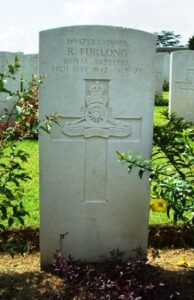
Albert Michael Griffiths, Flight Sergeant, 1382927, Royal Air Force Volunteer Reserve. Albert was born on 6 May 1917, the son of William George Griffiths and Clara Eliza Griffiths, of Shorncliffe, College Road, Carmarthen. He served in London as a Police Officer prior to the war, before enlisting into the Royal Air Force Volunteer Reserve, where he trained as a pilot. Albert was then posted to 72 Squadron, Royal Air Force, which had reformed at RAF Tangmere on 22 February 1937 from ‘B’ flight of 1 Squadron. In 1939, the squadron replaced its outdated Gloster Gladiators with Supermarine Spitfires and carried out air defence and convoy protection duties following the start of the war, before covering the troops withdrawing to Dunkirk. The squadron then took part in the Battle of Britain, and later moved to North Africa to support the Tunisian campaign. The squadron re-equipped with the faster Spitfire IX in 1942, and provided support to the 8th Army as it took part in the invasion of Italy. The squadron moved to Comiso in Sicily after the invasion of the Island in July 1943. Albert was killed during an operational flight on 16 July 1943, when fragments of a Messerschmidt Bf109 which he had shot struck his Spitfire, causing him to crash near Syracuse. The 26-year-old is buried in Syracuse War Cemetery, Sicily.
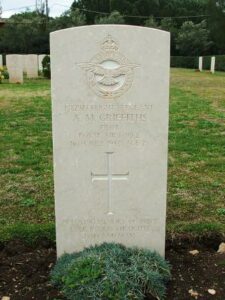
Cyril Elvet Griffiths, Sapper, 2000886, Royal Engineers. Cyril was born in 1919, the son of David Howell Griffiths and Sophia Griffiths (nee Davies), of Tegfan, Newchurch. He enlisted into the army soon after the outbreak of war and after being posted to the Royal Engineers embarked for Palestine with the 3rd (Cheshire) Field Squadron, Royal Engineers, which was attached to the 10th Armoured Division, under the command of General Bernard Montgomery. Cyril was killed in action in North Africa on 7 January 1942, not long after the division had moved to North Africa from Palestine. The 22-year-old has no known grave and is commemorated on the Alamein Memorial, Libya.
Leslie Evan Thomas Griffiths, 1279953, Aircraftman, Royal Air Force. Leslie was born in 1923, the son of David Griffiths and Mary Margaret Griffiths (nee Evans), of 102, St. Catherine’s Street, Carmarthen. He was baptised at St. Peter’s Church. Very little is currently known of him, but Leslie served with the Royal Air Force for most of the war, before becoming ill, and was discharged as medically unfit. He died of pulmonary tuberculosis at Carmarthen on 25 January 1947, aged 24. Nothing more is currently known of him, as he is not commemorated by the CWGC.
Reginald Thomas John Griffiths, Flight Sergeant, 640904, Royal Air Force. Reginald was born in 1921, the son of Thomas John Griffiths and Louisa Griffiths (nee Musson), of Cardiff. He married Gwyneth Margaret Griffiths, of Johnstown, Carmarthen, in 1943. Reginald had enlisted into the Royal Air Force Volunteer Reserve soon after the outbreak of war and after completing his training as an Air Gunner was posted to 10 Squadron, Royal Air Force, which was equipped with the Handley Page Halifax III, based at RAF Melbourne. On 19 July 1944 Reginald took off from Foggia Main Airfield in Italy aboard a Vickers Wellington X, Serial LN760, as part of a party of aircraft sent to hit targets in Fiume. Soon after take-off an engine burst into flames and the stricken Wellington crashed two miles northwest of the airfield, killing all her crew. Reginald was 23 years old when he was killed that day and is buried besides his fellow crewmen in Bari War Cemetery, Italy.
David Harold Harries, Sergeant, 1377756, Royal Air Force Volunteer Reserve. David was the son of Thomas and Annie Maria Harries of Penllwynau, Abergwili. He left home to work in a Drapery in Bromley prior to the war and lodged at 23, Palace Road, Bromley. David enlisted into the Royal Air Force Volunteer Reserve and after completing his training as a Wireless Operator/ Air Gunner was posted to 487 (RNZAF) Squadron, Royal Air Force, which was a New Zealand staffed squadron, equipped with the Lockheed Ventura II, based at RAF Feltwell. He married Joyce Lilian Worley, of Southwark, whilst on leave in Blackpool in the summer of 1941. On the night of 6 December 1942, David took off from Feltwell aboard a Lockheed Ventura II, Serial AE902, as part of Operation Oyster, a raid on the Philips radio and valve factory at Eindhoven. Some 93 bombers left Britain to attack the factory, which was extensively damaged, but there were 17 aircraft lost. Among those was the Ventura which David was a crewman in, which was hit by flak at low level and crashed, killing David and three other crewmen. David was 31 years old, and is buried in Eindhoven (Woensel) General Cemetery, Netherlands.
William John Healy, Private, 3956610, Welch Regiment. William was born in Laugharne in 1910, the son of William Reuben Healy and Hannah Ann Healy (nee Rowlands). He spent his early years living with his grandparents, Thomas and Maria Rowlands, at Frog Street, Laugharne, as his father was working as a Mason’s Labourer at Caerau. The family later moved to Blue Street, Carmarthen and after leaving school, William found work as a labourer. He married Mary Kezia Thomas, of Mill Street, Carmarthen at Christ Church on 23 April 1932. William enlisted into the Welch Regiment, and served throughout the war. He survived the conflict, but died as a result of his service in hospital at Leominster on 25 August 1946. The remains of the 35-year-old were brought home and he was buried in Carmarthen Cemetery.
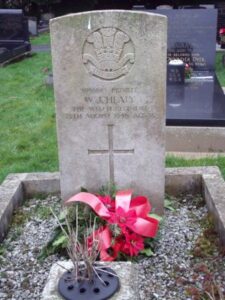
Albert Michael Herring, Fusilier, 14808829, Royal Welch Fusiliers. Albert was born in Ammanford in 1926, the son of David Ernest Herring and Revivalest Herring (nee Harries), of Ammanford. His mother died during childbirth, and Albert went to live with his grandparents, Moses and Amelia Harries, at 10, Pantyffynon Road, Ammanford. By 1929 his father had remarried to Mary Jane Jordan and Albert went to live with them at 18, Spilman Street, Carmarthen. Albert enlisted into the army as soon as he turned 18 and was posted to the 4th Battalion, Royal Welch Fusiliers, which was a Territorial Army unit attached to the 53rd (Welsh) Division. On 24 June 1944 the 4th RWF left England for Normandy, and landed at La Riviere near Ver Sur Mer. The Division then took part in heavy fighting over the coming weeks, as part of the effort to break-out of the Normandy beach-head, seeing heavy fighting at Évrecy, before starting the epic advance through Northern France into Belgium and Holland. On 15 September the Division forced the crossing of the Junction Canal North of Lommel, and continued to push westwards towards Elst, between Nijmegen and Arnhem, during Operation Market Garden. On 22 October the Division launched its famous assault on ‘s-Hertogenbosch, before continuing its advance to the German frontier. Between December 1944 and January 1945, the Division took part in the Battle of the Bulge, helping in the counter-attack which helped save the Americans, who were under heavy pressure, then after the German offensive was broken, took part in heavy fighting to enter the Rhineland, taking part in Operation Plunder, the Rhine Crossings, in March 1945. Albert was killed in Germany on 16 April 1945, during fighting near Altenwahlingen. The 19-year-old was buried in a temporary burial ground in Etelson, but in October 1946 the graves on the site were exhumed and re-interred in Becklingen War Cemetery, Germany.
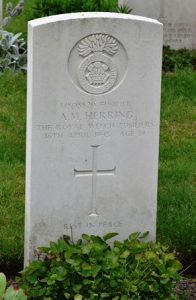
Peter Ralph Higgs, Trooper, 1421252, Nottinghamshire Yeomanry. Peter was born in Liverpool on 24 April 1924, the son of Pryce James Higgs, and of Lillian Higgs (nee Price). The family moved to 13, Parcyrafon Road, Carmarthen some time before the war. Peter enlisted into the army and was posted to the Nottinghamshire Yeomanry. The regiment had converted from a cavalry unit to artillery, moving to Palestine soon after the outbreak of war. It then took part in the defence of both Tobruk and Benghazi as well as the battle of Crete. In 1941, the Regiment converted to armour initially with M3 Grant and M4 Sherman medium tanks and Crusader cruiser tanks, joining the 8th Armoured Brigade, and took part in most of the major battles in the North Africa campaign. The regiment was then recalled to England to prepare for the Normandy Landings and landed in France on D-Day equipped with Duplex Drive Sherman and Sherman Firefly tanks and saw heavy fighting during the break out from Normandy and the subsequent drive north through Belgium towards Holland. Peter was killed in Belgium on 11 September 1944, just days before the launch of Operation Market Garden. The 20-year-old was originally buried in St. Dymphne’s Churchyard at Geel with two of his fellow crewmen, but in May 1945 their graves were exhumed and the men were buried in Geel War Cemetery, Belgium.
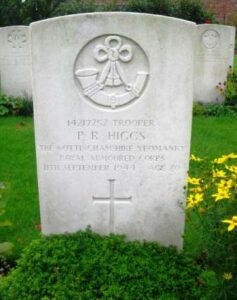
Waldo Harry Bentley Hiles, DSO, DFC, Squadron Leader, 121330, Royal Air Force Volunteer Reserve. Waldo was born in 1913, the son of Thomas Henry Hiles and Rosamund Sarah Hiles (nee Jones), of Myrtle Hill House, Fforestfach, Swansea. His father, a former steel worker, had made his way up the ladder to being a foreman and engineer, making his money in India before buying the Nelson Hotel, at Red Street, Carmarthen. Waldo was educated at St. Paul’s School, Darjeeling, India, and after the family moved to Carmarthen was educated at Llandovery College. Waldo enlisted into the Royal Air Force Volunteer Reserve soon after the outbreak of war and initially served as a Flight Sergeant. He married Elizabeth Anne Shanley in Witney, Oxfordshire in 1940 and the couple had a son, Jenkin Waldo Hiles. Waldo was commissioned from Flight Sergeant on 1 May 1942, then obviously being a brave and competent officer was soon promoted to Squadron Leader as well as receiving several awards for gallantry. On 12 December 1942, Waldo was awarded the DFC as Captain of a heavy bomber in an attack on Stuttgart whilst serving with 218 (Gold Coast) Squadron, Royal Air Force. The citation to his award read; ‘In November, 1942, this officer captained a heavy bomber, detailed to attack Stuttgart. At one point on the outward flight. Flight Lieutenant Hiles brought his aircraft down to 200 feet while his gunners attacked a goods train and put it out of action. He then flew on to his objective and bombed it. During the return journey, attacks were made on targets on the ground, including four separate attacks on goods trains and, in each instance, locomotives were set on fire; Flight Lieutenant Hiles also attacked an enemy aircraft on an airfield. This officer, who has completed a large number of sorties has invariably displayed outstanding skill and daring.’ In June, 1943 Waldo was awarded the DSO for his high qualities of leadership and devotion to duty with 218 Squadron. The citation which was published in the London Gazette of 11 June 1943 stated: ‘Squadron Leader Hiles has been flying on operations since May, 1941, and has completed numerous sorties since being awarded the D.F.C. He always presses home his attacks in the most determined manner, flying at low altitude regardless of enemy opposition.’ He had completed two full tours of operations with 218 Squadron when he was transferred and posted to No. 3 Group HQ at Exning Hall, effectively taking him off active duties, but on the morning of 24 August 1943 Waldo decided to pay a visit to his former Squadron. After sitting in on the briefing for the raid that night on Berlin, Waldo decided to take part himself. He collected a scratch crew made up of inexperienced airmen from the Squadron, and took control of a Short Stirling III, Serial EH925 IC-C of 623 Squadron. Sadly the Stirling was intercepted by a German night fighter and shot down some 25 miles south of Berlin that night, and the entire crew was lost without trace. Waldo was 30 years old when he was killed that night and is commemorated on the Runnymede Memorial, Surrey. His brother, William Jenkin Joseph Hiles, was killed in 1944.
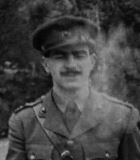
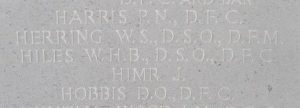
William Jenkin Hiles, Captain, Royal Marines. William was born on 4 January 1915, the son of Thomas Henry Hiles and Rosamund Sarah Hiles (nee Jones), of Myrtle Hill House, Fforestfach, Swansea. His father, a former steel worker, had made his way up the ladder to being a foreman and engineer, making his money in India before buying the Nelson Hotel, at Red Street, Carmarthen. William was educated at St. Paul’s School, Darjeeling, India, and after the family moved to Carmarthen was educated at Llandovery College. William enlisted into the Royal Marines soon after the outbreak of war and on 25 October 1941 was commissioned as a Lieutenant, being posted to No. 40 Royal Marine Commando. A further promotion to Captain followed on 9 October 1943. The Commandos were a newly formed unit, made up from elite soldiers, highly trained and motivated. 40 RM Commando was sent to Sicily in July 1943 and a little later in September it saw action at Pizzio. Later that year the Commando was in action at Termoli, and in 1944 was involved in the fighting at Anzio. At dawn on 9 October 1944, 40 Commando Royal Marines launched a raid on the Southern Albanian town of Saranda. They landed on ‘Sugar Beach’ where they encountered strong resistance from German forces. Having managed to fight their way off the beach they joined up with local partisans and continued their assault, eventually subduing the Germans. With the port of Saranda liberated, German forces on the Greek island of Corfu found their escape route blocked and capitulated to the allies. William, in Command of X Troop, was killed by machine-gun fire during the assault on Saranda on 9 October 1944. The 29-year-old is buried at Tirana Park Memorial Cemetery, Albania. His brother, Waldo Harry Bentley Hiles, had been killed in Germany in 1943.
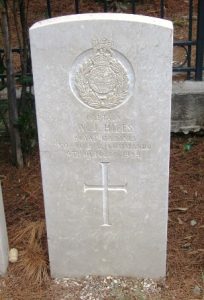
Leslie Holmes, Private, 3959228, Dorsetshire Regiment. Leslie was born in 1915, the son of Daisy Maud Holmes. He was then fostered by Jane Vaughan, of Carmarthen. Leslie enlisted into the army and was posted to the 1st Battalion, Dorsetshire Regiment. The battalion joined the newly formed 231st Infantry Brigade at Malta in April 1943, before joining the Eighth Army in North Africa. The battalion then took part in Operation Husky, the invasion of Sicily, before joining the fight on mainland Italy. The 231st Brigade then joined the 50th (Northumbrian) Infantry Division and was recalled to England with the division to prepare for the invasion of Normandy, landing at Gold Beach on 6 June 1944. The 50th Division saw heavy fighting during the Normandy campaign, then took part in the drive through Northern France into Belgium and Holland, crossing the Rhine at Arnhem on 26 September 1944. Leslie was killed in action during the Battle of the Nijmegen salient, on 10 November 1944. The 29-year-old was originally buried in a plot south of Bemmel Church, then in October 1945 the graves within the plot were exhumed and re-interred in Arnhem Oosterbeek War Cemetery, Gelderland, Netherlands.
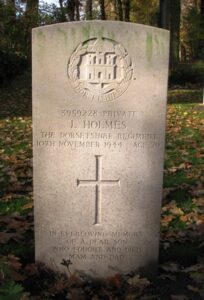
James Hywel Hughes, Sergeant, 1381323, Royal Air Force Volunteer Reserve. James was born on 27 August 1921, the son of William David Hughes and Margaret Hughes (nee Phillips), of Knightsford, near Carmarthen. He worked as a farm worker farm prior to enlisting into the Royal Air Force Volunteer Reserve and after completing his training as a Wireless Operator/Air Gunner was posted to 77 Squadron, Royal Air Force, which was equipped with the Handley Page Halifax II, based at RAF Elvington. On the night of 9 March 1943, James took off from Elvington aboard a Handley Page Halifax II, Serial JB795, which joined a large bomber group despatched to destroy targets in Munich, including the BMW Aero Engine Factory. During the early hours of 10 March 1943, the Halifax was hit by enemy fire and crashed into Lake Constance, killing all her crew of seven. James was just 21 years old when he died that night. His body was later recovered from the lake together with those of his fellow crewmen and buried in Friedrichshafen Cemetery, but in August 1948 the graves of the seven men were exhumed and re-interred in Durnbach War Cemetery, Germany.
John Hurley, Private, 33298, Welch Regiment. John was born on 9 April 1899, the son of Johanna Hurley, of 49, Mill Street, Carmarthen. His mother, widowed some years earlier, died in 1911 and John was adopted by Ada Thompson, of 15 Mill Street Carmarthen. Following Ada’s death in 1916, John served during the Great War, and upon being discharged married Susan Booth at Llanelli in 1920. The couple then resided at 6, Morlais Terrace, Trimsaran and John gained work as a builders labourer. He was probably a member of the Territorial Army and re-enlisted into the Welch Regiment soon after the outbreak of war. He died on active service in Cheshire on 9 December 1941. The 44-year-old was buried in Chester (Overleigh) Cemetery. His wife Susan had died at Llanelli in 1940, aged 37.
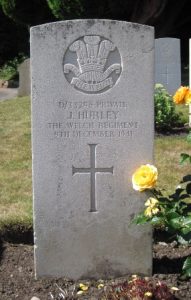
Mary James (nee Davies), Civilian. Mary was born on 16 October 1907, the daughter of Henry James Davies and Elizabeth Davies (nee Griffiths), of 62 Richmond Terrace Carmarthen. She married John Henry James in Eastry, Kent in 1935 and the couple settled at 35, Bell Grove, Eastry. Tragically Mary, her husband John, and their youngest daughter, Margaret, were killed at home during an air raid on 6 May 1941. Mary was 33 years old; John was 44 years old; and Margaret was just 5 years old. Two sons, Thomas and Cyril James, were both orphaned and came to Carmarthen to live with their grandparents. One of Mary’s brothers, Gwilym Davies, who had been lodging with them in 1939, also lost his life during the war.
David William Phillip Jenkins, Private, 3970038, Welch Regiment. David was born in Newport, Monmouthshire on 17 September 1913. He came to Carmarthen as a young man to work at the Milk Factory in Johnstown. David married Minnie Griffiths in Llangunnor in 1937 and the couple set up home together at 20, Davies Town, Pensarn. David initially served with the Welch Regiment, but volunteered to serve with the Army Commandos and was posted to the Commando Training Centre at Achnacarry, Scotland, where he joined No. 12 Commando. David was killed during exercises at Achnacarry on 8 August 1941. The remains of the 26-year-old were brought home and he was buried in St. Cynwyr’s Churchyard, Llangunnor on 12 August.
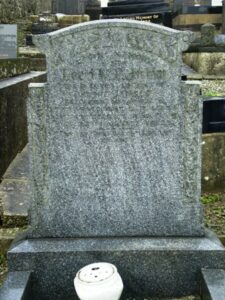
Samuel Leslie Jenkins, Captain, 88225, South Wales Borderers. Samuel was born in 1915, the son of John Jenkins and Ellen Jenkins (nee Bowen), of 4, Mansel Street, Carmarthen. He lived with his wife Jean Rosaleen Jenkins at Llanarthney prior to the war. Samuel had enlisted into the South Wales Borderers, but soon rose to the rank of Captain, before applying for Commando training, and after completing his Command course at Achnacarry was posted to No. 2 Commando. Samuel was wounded during operations on Sicily on 16 August 1943 but returned to duty as soon as he had recovered. On 4 March 1944 Samuel and another officer of 2 Commando were on reconnaissance in preparation for a raid on Solta, when Samuel was wounded and captured. He died of his wounds as a POW on 6 March 1944. The 29-year-old is buried in Belgrade War Cemetery, Serbia & Montenegro. There is a fine memorial processional cross to Samuel inside Llanarthney Church.
William James Polson Jenkins, Stoker 1st Class, C/KX89342, Royal Navy. William was born on 29 March 1915, the son of William James Jenkins and Ethel Maud Jenkins (nee Polson), of 11, Glannant Road, Carmarthen. He left home as a young man to enlist into the Royal Navy and soon after the outbreak of war was posted aboard the K-class destroyer HMS Kelly, which was under the command of Captain (later Lord) Louis Mountbatten. In late 1939 the Duke of Windsor was evacuated from exile in France aboard HMS Kelly, then in early May 1940 Kelly led a British convoy in through the fog to evacuate the Allied forces from Norway. On the night of 9–10 May 1940, Kelly was searching for a German U-Boat in the North Sea, along with the destroyers HMS Kandahar and HMS Bulldog, when they came under torpedo attack by swift moving German E-Boats. Kelly was hit by a torpedo which had been fired by the E-Boat S31, and sustained serious damage, with the boiler room being flooded. William was among 27 men killed in the explosion. The body of the 25-year-old was recovered from the sea and he was buried with full military honours in Hebburn Cemetery, Newcastle-on-Tyne. HMS Kelly, still under the command of Mountbatten, was lost off Crete the following year.
Benjamin Bryn Jones, Sergeant, 1183725, Royal Air Force Volunteer Reserve. Benjamin was born on 21 June 1920, the son of Henry Jones and Margaret Jones, of 93a, Priory Street, Carmarthen. He worked as a fruiterer for his father prior to enlisting into the Royal Air Force Volunteer Reserve and after completing his training as an Air Gunner was posted to 207 Squadron, Royal Air Force, which was equipped with the Avro Lancaster I, based at RAF Langar. On the night of 26 April 1943, Benjamin took off from Langar aboard an Avro Lancaster I, Serial W4171, which joined a large bomber group despatched to strike targets in Duisberg. During the early hours of the following morning, 27 April 1943, the Lancaster was intercepted by a German night fighter and shot down at Mol, some six miles Northeast of Geel, killing all seven of her crew. Benjamin was 22 years old when he was killed that night, and was buried together with his fellow crewmen in Schoonselhof Cemetery, Belgium.
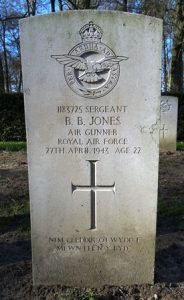
Bryn Myrddin Jones, Lance Corporal, 2738087, Welsh Guards. Bryn was born in Pontypridd in 1922, the son of Edward and Hannah Jones. He married Lilian Adeline Lewis, of 37, Water Street, in Carmarthen in 1942. Bryn enlisted into the army and was posted to the 2nd Armoured Reconnaissance Battalion, Welsh Guards. The battalion had been decimated at Boulogne in 1940 and had been rebuilt back in Britain before being converted into an armoured unit. The 1st and 2nd Battalions, Welsh Guards landed in Arromanches between 18-29 June 1944 and took part in the break-out from the Normandy beach-head and the terrible fighting in the Bocage. During the end of August and early September the Welsh Guards took part in the drive through northern France, reaching the World War One battlefields of Arras before heading north into Belgium. On 3 September the Welsh Guards liberated Brussels before advancing through Wavre, Helchteren, Hechtel and Leopoldsburg. Bryn became one of many casualties suffered by the Welsh Guards when he was killed near Leopoldsburg on 12 September 1944. The 22-year-old was originally buried in Hechtel, together with three other Welsh Guardsmen killed that day. In April 1946 the mens graves were exhumed and they were re-interred in Leopoldsburg War Cemetery, Belgium. The sad epitaph placed on his headstone by his wife reads:
We Planned a Lovely Future
Only to end in a Dream
I Think of you Always Dear
And of What Might Have Been

Brynmor Samuel Jones, Sergeant, 1061957, Royal Air Force Volunteer Reserve. Brynmor was born on 5 January 1916, the son of George and Eliza Jones, of 43, St. Catherine Street, Carmarthen. He worked as a clerk for the Carmarthenshire Insurance Company prior to enlisting into the Royal Air Force Volunteer Reserve, and after completing his training as an Air Gunner was posted to 57 Squadron, Royal Air Force, which was equipped with the Vickers Wellington II, based at RAF Feltwell. On the night of 15 October 1941, Brynmor took off from Feltwell aboard a Vickers Wellington IC, Serial X9978, which joined a large bomber group despatched to strike targets in Cologne. During the early hours of the following morning, 15 October 1941, the Wellington was intercepted by a German night fighter, and was shot down, crashing with the loss of all six of her crew at Grevenbicht, some five Miles Northwest of Sittard. Brynmor was 25 years old when he was killed that night and was buried alongside his fellow crewmen in Venlo British Cemetery. In August 1947 the cemetery was cleared and the war graves were re-interred in Jonkerbos War Cemetery, Netherlands.
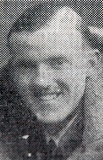
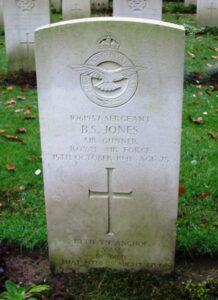
David Richard Jones, Driver, T/255874, Royal Army Service Corps. David was born at Carmarthen in 1904. He served as a Driver with the Royal Army Service Corps. Very little is known of him, but he died on 27 December 1942 aged 38, and is buried in Gibraltar (North Front) Cemetery, Gibraltar.
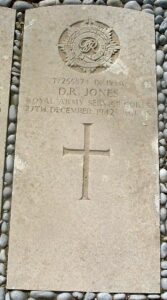
Derric Isaac Jones, Flying Officer (Navigator/Bomber), 120809, Royal Air Force Volunteer Reserve. Derric was born in 1920, the son of David John Jones and Margaret Ann Jones (nee Owen), of 7, Water Street, Carmarthen. After leaving Carmarthen Grammar School he enlisted into the Royal Air Force Volunteer Reserve and after training as a Navigator/ Bomber was posted to No. 1 (Coastal) Operational Training Unit, for specialist training prior to joining a front-line squadron. At just after midnight on the morning of 10 November 1942, Derrick took off from RAF Silloth, on the Solway Firth, as Navigator of a Lockheed Hudson, Serial AM680, flown by Flight Sergeant John Frederick Saunders, on a night navigation exercise. About half an hour later the aircraft sent out a radio message, stating: ‘I will call you again later’, but nothing more was heard. The Hudson had crashed at Beda Fell near Ullswater in thick fog on 10 November 1942, bursting into flames on impact, and killing all five men aboard. The local police and the RAF sent out search parties to try and find the aircraft, and it was not until the following day that the wreckage was located. Derrick was 22 years old when he was killed during the crash. His remains were recovered from the wreckage and he was brought home for burial in Carmarthen Cemetery.
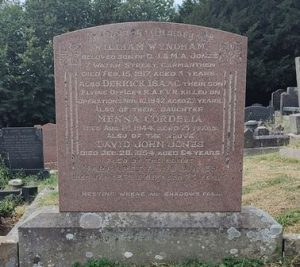
Herbert Llewelyn Jones, Sergeant (Flight Engineer), 570542, Royal Air Force. Herbert was born on 2 January 1921, the son of David John Jones and Esther Elizabeth Jones (nee Walters), of 51, High Street, Abergwili. His mother Elizabeth died in 1923, and Herbert went to live with his grandparents, John and Harriet Jones and at Brynderwen, Llanarthney. After leaving his local school at Llanarthney, Herbert gained a place in Carmarthen Grammar School. He enlisted into the Royal Air Force upon leaving school and after completing his training as a Flight Engineer was posted to 9 Squadron, Royal Air Force, which was a medium bomber Squadron, originally equipped with the Vickers Wellington. The squadron utilised their Wellington’s on anti-shipping sorties in the early stages of the war, before converting to Avro Lancaster’s in September 1942 and joined RAF Bomber Command, based at RAF Waddington. On the night of 4 April 1943 Herbert took off from Waddington aboard Avro Lancaster, Serial ED696 which was part of a force bound for Kiel. The Lancaster was intercepted by a German night-fighter on the following morning, 5 April 1943, and crashed in flames near Grossenaspe, killing all seven of her crew. Herbert, who was just 22 years old, was buried alongside his fellow crewmen in Neumunster Civil Cemetery, but their graves were later exhumed and they were re-interred in Hamburg Cemetery, Germany in September 1946. His uncle, Herbert James Jones, fell during The Great War.
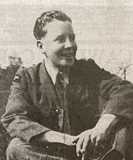
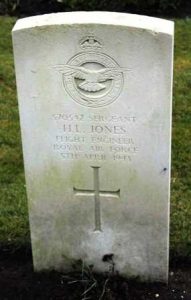
Ivor Maurice Jones, Lieutenant, Royal Australian Naval Volunteer Reserve. Ivor was born on 13 May 1907, the son of Arthur and Edith Jones, of Brynglas, Union Street, Carmarthen. He had served with the Royal Navy prior to the war, prior to emigrating to New Zealand, and lived with his wife Gwendoleen Maheno Jones, at Eketahuna, New Zealand. Ivor enlisted into the Royal Australian Navy soon after the outbreak of war and on 15 September 1940 was granted an emergency commission as Sub-Lieutenant. He trained at Brushcutter and Cerburus, then had several postings aboard a number of Australian vessels before being promoted to Lieutenant and posted aboard the County-class heavy cruiser HMAS Australia on 21 March 1944, the day that she rejoined Task Force 74, following a refit. The force then left Australia to support the amphibious landings at Aitape, Humboldt Bay, and Tanahmerah Bay, before providing artillery support for the troops ashore, then began carrying out escort duties. HMAS Australia had a very busy summer, with the war in the Pacific at an intense level. At around 06:00 on 21 October 1944, Japanese aircraft attacked Australia and a number of other ships in Leyte Bay. A Japanese Aichi D3A dive-bomber dove for HMAS Shropshire, but was hit by anti-aircraft fire before diving into HMAS Australia, hitting her bridge and showering the ship with debris and burning fuel. Ivor was one of seven officers, including the Captain, and twenty-three sailors killed by the explosion, whilst another nine officers, fifty-two sailors, and an AIF gunner were wounded. Ivor was 37 years old when he was killed that day, and is commemorated on the Plymouth Naval Memorial, Devon.
Mervyn Anthony Jones, Flight Sergeant, 748630, Royal Air Force Volunteer Reserve. Mervyn was born at Llwynwhilwg Farm, Llanelli on 12 May 1919, the son of Herbert Jones and Anne Elisabeth Jones (nee Anthony). The family later owned Cillefwr Farm, Carmarthen and Mervyn was educated at Queen Elizabeth’s Grammar School, Carmarthen. Mervyn was a well-known jockey prior to the war and had won the Grand National Steeplechase in 1940, riding Bogskar, not long after having enlisted into the Royal Air Force along with his brother William. Both men qualified as Pilots, and Mervyn was posted to No. 1 Photographic Reconnaissance Unit, Royal Air Force, which was equipped with the Supermarine Spitfire. Mervyn was posted missing after a North Sea sortie on 3 April 1942, when his Spitfire, Serial AA797, was intercepted and shot down into the Fjord between Frosta and Tømmerdalen in Leksvik. Mervyn parachuted, but drowned before a German rescue launch could save him. The 22-year-old has no known grave, and is commemorated on the Runnymede Memorial, Surrey. His brother William was killed just over two years later. Both brothers medals were sold at Dix Noonan Webb on 6 July 2004. A fellow Spitfire from the same unit, Spitfire, AA810, has recently been discovered and recovered from the same Fjord and is in the process of being restored.
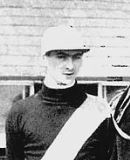
Percy Edwin Jones, Private, 3909354, South Wales Borderers. Percy was born on 24 December 1914, the son of Theodosius Jones and Martha Jane Jones (nee Pugh), of 28, Cambrian Place, Carmarthen. He left home as a young man to enlist into the 2nd Battalion, South Wales Borderers. The battalion landed in Norway in April 1940 to support the Norwegian army against any possible German attacks, landing at Harstad in mid-April and moved in Norwegian fishing boats to the Ankenes Peninsula opposite Narvik where they were to support a drive towards Narvik by the Chasseurs Alpins. On 30 April the battalion saw its first action against the Germans on the Ankenes Peninsula, and on the following day successfully beat off a German assault. Percy was killed here together with three other men of the 2nd SWB on 2 May 1940. The 24-year-old was buried in Ballangen New Cemetery, Norway.
Richard Glynne Jones, Aircraftman 2nd Class, 1171578, Royal Air Force Volunteer Reserve. Richard was born on 7 August 1915, the son of Richard Garrick Jones and Lucy Jones (nee Angelinetta), of 6 Chaxton Street, Oxford. His father was from Carmarthen and had worked as a compositor with the Weekly Reporter in Carmarthen until serving in the Great War, and his Aunt was Mrs Parson, of 11 Friars Park, Carmarthen. Richard worked as an electrician prior to enlisting into the Royal Air Force and was posted to RAF Honington, as Ground Crew. During the afternoon of 19 August 1940, the Germans launched two intruder attacks on RAF Honington. The first attack took place at 16.15, killing four servicemen and injuring many others, whilst HE bombs were later dropped and fell around the parade square. Richard was among the four killed that day. The 25-year-old was buried in All Saints Churchyard, Honington, Suffolk.
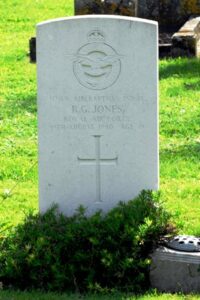
William Hywel Anthony Jones, DFC, Flying Officer, 139316, Royal Air Force Volunteer Reserve. William was born at Llwynwhilwg Farm, Llanelli on 25 December 1915, the son of Herbert Jones and Anne Elisabeth Jones (nee Anthony). The family later owned Cillefwr Farm, Carmarthen and William and his brother Mervyn were educated at Carmarthen Grammar School. William was a well known jockey like his brother Mervyn, and rode against him in the 1940 Grand National, falling from his horse ‘National Night’. William had enlisted into the Royal Air Force Volunteer Reserve with Mervyn, and qualified as a Pilot, joining 517 Squadron, Royal Air Force, which was a Coastal Command unit, equipped with the Handley Page Halifax V, based at RAF Brawdy. During the war, William made several daring attacks against German U-Boats. He was awarded the Distinguished Flying Cross, and was also Mentioned in Despatches for his gallantry during the war. The recommendation for his DFC, published in the London Gazette of 20 August 1943, read; ‘Pilot Officer Jones has maintained a very high standard in his work throughout his operational career. He made four attacks on U-Boats, inflicting damage on three occasions. He has also made a very determined attack on a blockade runner. Recently he was captain of an aircraft which successfully fought off attacks by seven Ju. 88s over a period of 45 minutes. The safe return of the aircraft was largely due to this officer’s fine tactics and superb airmanship.’ His Mention in despatches was listed in the London Gazette of 1 January 1943. William was posted missing during his second tour of operations on 14 November 1944 when his Wellington was forced to ditch off Lundy Island, in the Bristol Channel, when unable to land due to bad weather conditions, after returning from a Meteorological Recce Sortie. The 29-year-old has no known grave and is commemorated on the Runnymede Memorial, Surrey. His medals were sold along with Mervyn’s in a Dix Noonan Webb Auction on 6 July 2004.
William Llewellyn Wynn Jones, Flying Officer, 135670, Royal Air Force Volunteer Reserve. William was born on 5 February 1909, the son of John Henry Jones and Martha Lilian Jones, of The Globe Inn, Blaina. He studied at Trinity College, Carmarthen prior to becoming a schoolteacher, and upon his return to Blaina married Florence Eileen Chaffey. The couple then moved to 90, Rectory Road, Thurrock, where William had gained a position as Deputy Schoolmaster. William enlisted into the Royal Air Force Volunteer Reserve soon after the outbreak of war and after qualifying as a Navigator was posted to 514 Squadron, Royal Air Force, which flew the Avro Lancaster II, based at RAF Waterbeach. On 1 May 1944, William took off from Waterbeach aboard an Avro Lancaster II, Serial LL732, which joined a large bomber group despatched to hit railway installations in Chambly, the main railway depot and stores for the northern French railway network. The raid was extremely successful, but during the return leg on the following morning, 2 May 1944, William’s Lancaster was intercepted and shot down by a German night-fighter, crashing near Chaumont-en-Vexin, France, with the loss of all seven crewmen. William was 35 years old when he was killed that day and was buried besides his fellow crewmen in St. Sever Cemetery Extension, Rouen, France. His widow, Florence, went to live with her parents at Bourneville, Birmingham after William’s death. She never remarried and died in 2004.
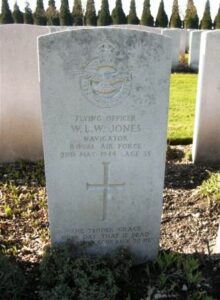
Norman Douglas Kay, Lance Bombardier, 905441, Royal Artillery. Norman was born in Croydon in 1921, the illegitimate son of Gladys Ivy Kay. Gladys was the daughter of Thomas Robert Kay and Caroline Gertrude Kay (nee Mennell), of Market Deeping. Her father was the Headmaster of Market Deeping School and it appears that Gladys was sent away to have her son. She married in 1925. Norman enlisted into the Royal Artillery soon after the outbreak of war and was posted to the 97th (The Kent Yeomanry) Field Regiment, Royal Artillery. The Regiment mobilized at Maidstone on 3 September 1939 under Eastern Command with the 385th (Duke of Connaught’s Own Yeomanry) and the 387th (Queen’s Own Yeomanry) Batteries, before moving to France as part of the 5th Division of the BEF. The survivors of the Regiment were evacuated from Dunkirk in Operation Dynamo by HMS Winchelsea, having destroyed its guns and equipment. It is not known if Norman served in France during this period, but he died at Carmarthen Hospital on 10 November 1940. The 19-year-old was buried in Carmarthen Cemetery.
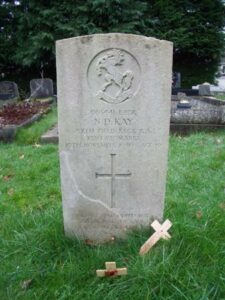
Alan John McLaren Keay, Aircraftman 2nd Class, 305234, Royal Air Force Volunteer Reserve. Alan was born on 22 January 1926, the son of Cyril Francis McLaren Keay and Dorothy Margaret Keay (nee McLeod), of Leicester. He was educated at Carmarthen Grammar School prior to enlisting into the Royal Air Force Volunteer Reserve and was posted to No 16 Elementary Flight Training School at Burnaston, Derbyshire to train as a pilot. On 9 March 1945 Alan was flying a Tiger Moth II, Serial DE473, in poor visibility when it collided with a Handley Page Halifax of 1665 Heavy Conversion Unit near Abbotts Bromley, killing Alan and his instructor and also the entire crew of the Halifax. Alan was 19 years old and is buried in Repton (St. Wystan) Churchyard, Derbyshire.
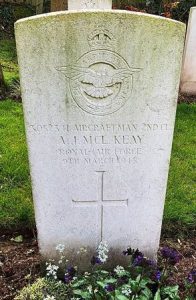
John Daniel Kingdon, Sergeant, 1013673, Royal Air Force Volunteer Reserve. John was born on 7 September 1911, the son of Daniel Richard Kingdon and Alice Kingdon (nee Burnell), of 95, Llandaff Road, Cardiff. He married Dora Howard Parfitt at Cardiff in the Spring of 1939 and the couple came to live at 17, Millbrook Crescent, Carmarthen, after he had gained work in the town as an Insurance Inspector. John enlisted into the Royal Air Force Volunteer Reserve soon after the outbreak of war and after training as a Pilot was posted to 9 Squadron, Royal Air Force, which flew the Vickers Wellington IC, initially based at RAF Lossiemouth. On the night of 23 June 1942, John took off from RAF Honington, flying a Vickers Wellington III, Serial X3423, which joined thirteen other aircraft on a raid on the dockyards at St. Nazaire. The raid was a failure, due to the target being missed by eleven of the aircraft, so the raiders headed back to England. John’s Wellington crashed into the ground near Wantage during the early hours of 24 June 1942, killing John and three of his crew. The remains of the 30-year-old were recovered from the wreckage and he was cremated at Pontypridd Crematorium. His widow, Dora, later remarried and continued to live in Carmarthen.
David Daniel Lewis, Private, 3955577, South Wales Borderers. David was born in 1910, the son of William Lewis and Mary Lewis (nee Hughes), of 2, Little Bridge Street, Carmarthen. He married Alice Eileen Hurley in 1930, and the couple resided at 51, Pentrefelin Street, Carmarthen. David enlisted into the army and served with the South Wales Borderers. He died on active service on 13 December 1941. The 31-year-old was buried in St. Cynwyr’s Churchyard, Llangunnor on 16 December.
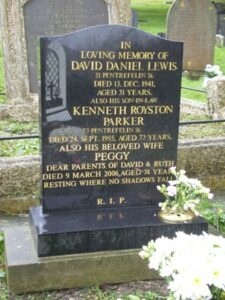
Desmond Lewis, Sergeant, 1414771, Royal Air Force Volunteer Reserve. Desmond wwas born in 1925, the son of William Titus Lewis and Margaret Lewis (nee Evans), of 55, Abergwili Road, Carmarthen. After leaving Carmarthen Grammar School he enlisted into the Royal Air Force Volunteer Reserve and after completing his training as an Air Bomber, he was posted to 429 (Royal Canadian Air Force) Squadron, Royal Air Force, which flew the Vickers Wellington Mark X based at RAF East Moor. On the night of 26 January 1943, Desmond took off from East Moor aboard a Vickkers Wellington III, Serial BK163, which joined a force of 156 other bombers sent to bomb the U-Boat pens at Lorient, in France. Desmond was killed, together with his entire crew, when their Wellington was lost without trace on the following morning, 27 January 1943. Desmond was just 17 years old when he was killed that night. He has no known grave, so is commemorated on the Runnymede Memorial, Surrey. He was in fact one of the youngest men to be killed serving with Bomber Command during the war.
Edward Morland Lewis, Captain, 171535, General List. Edward was born in Carmarthen in 1903, the eighth son of Benjamin Archibald Lewis and Mary Lewis (nee Fuller), of Morfa House, Carmarthen. His father had been the Manager of the Carmarthen Gas Works, but after retiring moved the family moved to Undercliff, Ferryside. After leaving Carmarthen Grammar School, Edward trained at St John’s Wood School of Art and at the Royal Academy, London where he became a favoured student of Sickert, and painted many local scenes, especially of Ferryside. He then joined the staff of Chelsea College of Art, where his colleagues included Henry Moore, Graham Sutherland and John Piper. Edward married Kathleen Margaret Faussett-Osbourne, a fellow artist, of Kensington, London, in the Spring of 1940. He gained a commission into the army soon after the outbreak of war, being placed on the General List, and was posted to North Africa, where he served as a Camouflage Officer. Edward died of malaria in hospital in Tunisia on 4 August 1943. The 40-year-old was buried in Medjez-El-Bab War Cemetery, Tunisia.
John Charles Lewis, Chief Engineer Officer, Merchant Navy. John was born in Carmarthen in 1879, the son of Thomas and Susan Lewis. He was baptised at St. Peter’s Church on 4 February 1880. John’s father Thomas was a Compositor and by 1901 the family had moved to 5, Cardiff Road, Llandaff. John then enlisted into the Merchant service, training as a Marine Engineer. He married Elizabeth Pollard at Cardiff on 14 August 1915 and the couple set up home at Ivanhoe, Bloomfield Road, Bath. By the start of the war John was Chief Engineer aboard the Newcastle-on-Tyne registered cargo steamer SS Hillfern. On 31 October 1940 Hillfern sank about eight miles off Kinnaird Head, with the loss of eight of her crew. There are conflicting reports of her loss, either by striking a mine, or being attacked by German aircraft. John was among the men lost. He was 61 years old, and is commemorated on the Tower Hill Memorial, London.
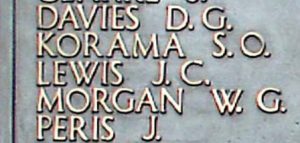
John Irfon Lewis, Leading Aircraftman, 649703, Royal Air Force Volunteer Reserve. John was born in 1921, the son of Robert Lewis and Mary Ceinwen Lewis (nee Price), of Rose Cottage, Carmarthen. He enlisted into the Royal Air Force Volunteer Reserve and after completing his training was posted to Egypt to join 14 Squadron, Royal Air Force, which was equipped with the Martin B-26 Marauder I, based at RAF Fayid. John initially served as Groundcrew, but then became a Flight Engineer. On 1 March 1943 he took off from RAF Faid aboard a Martin B-26 Marauder, Serial FK117, on a training flight, piloted by Pilot Officer Fletcher. The men began to practicing single-engine circuits at Fayid, but whilst approaching the airfield to land, after their circuits, the aircraft stalled and the pilot lost control, crashing short of runway, killing John and himself. John was 21 years old when he was killed that day, and he was buried in Fayid War Cemetery, Egypt.
Victor John Lewis, Lance Sergeant, 2036333, Parachute Regiment. Victor was the son of William Henry Lewis and Hannah Lewis (nee Manders), of 21, Tabernacle Road, Carmarthen. He enlisted into the army and was posted to the 10th Battalion, Parachute Regiment, which was formed at Kabrit in 1943. The battalion fought in Italy with the 4th Parachute Brigade, before returning to England. It didn’t take part in D-Day, but on 18 September 1944 jumped into Arnhem, and took over the Groesbeek perimeter, during Operation Market Garden. Victor was wounded on 21 September 1944, and was last seen being carried to a first aid post. No trace of him was ever found, and he was recorded as missing, but was later posted as missing, believed died of wounds, on 21 September 1944. The 26-year-old has no known grave, so is commemorated on the Groesbeek Memorial, Gelderland, Netherlands. His battalion, 10 Para, was virtually annihilated in the besieged Oosterbeek 1st Airborne Division perimeter.
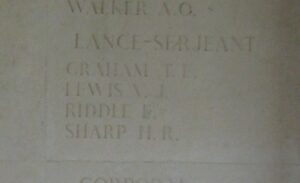
Harold Profit Lloyd, Gunner, 11259671, Royal Artillery. Harold was born on 22 October 1902, the son of Thomas Lloyd and Caroline Louisa Lloyd (nee Profit), of 45, Little Water Street, Carmarthen. He married Gwenllian Minnie Jones in 1930 and the couple went to live at 206, Victoria Road, Birmingham after Harold had found work there as a metalworker. He enlisted into the Royal Artillery soon after the outbreak of war and was posted to 505 Battery, 163 Heavy Anti-Aircraft Regiment, Royal Artillery. The regiment was a Territorial Army unit and after its formation was posted to London, to provide air defence cover for the city. Harold died on active service in Kent on 10 April 1945. The remains of the 42-year-old were brought home and he was buried in Carmarthen Cemetery.
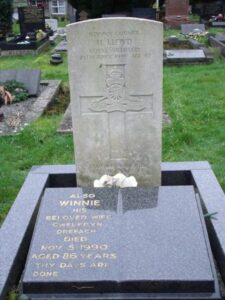
Harold Melville Maynard, Radio Officer (Junior), Merchant Navy. Harold was born in 1924, the son of Charles Maynard and Hilda Grace Maynard (nee Swain), of 4, Heol Spurrell, Carmarthen. He enlisted into the Merchant Navy and became a Radio Officer before being posted aboard the London registered cargo ship MV Silverpalm. The ship left Calcutta on 17 April 1941 carrying some 9,000 tons of general cargo, bound firstly for Capetown, then Freetown, which it left on 31 May, bound for Glasgow. At sometime after 9 June 1941 Silverpalm went missing in the North Atlantic, after having probably been sunk by a German U-Boat, possibly U-371, which reported sinking a merchant vessel on 12 June 1941. Nothing is properly known of her fate, as all crew were lost. Harold was 17 years old, and is commemorated on the Tower Hill Memorial, London.
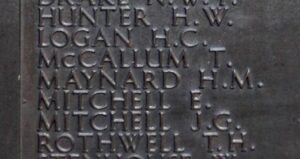
Norman George Miller, Private, 4202053, Leicestershire Regiment. Norman was born on 8 November 1914, the son of Frederick Miller and Annie Miller (nee Lewis), of 68, St. Catherine Street, Carmarthen. He worked as a cheesemaker at the dairy at Johnstown prior to the war and after marrying Elizabeth Ann Lewis, in 1938, the couple set up home at Brynmeurig, Pensarn. Norman enlisted into the army soon after the outbreak of war and was posted to the 2/5th Battalion, Leicestershire Regiment. The Battalion was mobilised in 1939 and went to France in 1940 as part of the 46th Division. It remained in England after the evacuation from Dunkirk, before embarking for the Mediterranean to take part in Operation Torch in January 1943, seeing heavy fighting at the Kassarine Pass. The Battalion then took part in the landings at Salerno, and crossed the Volturna and Teano Rivers. Norman was badly wounded in Italy on 9 September 1943, and died of his wounds on 20 November 1943. The 29-year-old was buried at Bone War Cemetery, Annaba, Italy. Elizabeth passed away in 1976, and is buried in St. Cynwyr’s Churchyard, Llangunnor.
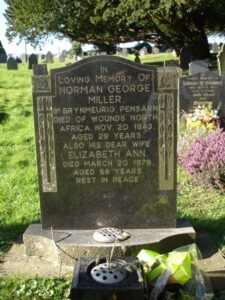
Brinley Morgan, Private, 2140911, Pioneer Corps. Brinley wwas born at Llangunnor on 6 August 1908, the son of William Morgan and Annie Morgan. The family had moved to 7, Little Water Street, Carmarthen by 1911. Brinley worked as a gardener prior to the war and lodged at Penymorfa Cottage, Pensarn. He left Carmarthen to enlist into the Royal Engineers soon after the outbreak of war and was posted to the 59th Field Company, Royal Engineers, which was attached to the 4th Division. The Division had suffered severe casualties in France in 1940 and spent two years rebuilding before embarking for North Africa early in 1943. The Division then joined the First Army for the final stages of the Tunisian Campaign, seeing heavy fighting during Operation Vulcan, the final ground attack against Axis forces in North Africa which led to the surrender of the Afrika Korps in May 1943. The Division remained in North Africa for the coming months, before landing on mainland Italy. Brinley was accidentally killed in Italy on 18 October 1943. The 35-year-old was buried in Naples War Cemetery, Italy.
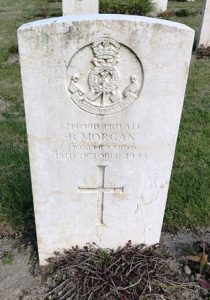
Daniel George Morgan, Cook, Merchant Navy. Daniel was born in 1920, the son of John Daniel Morgan and Gwenllian Morgan (nee Thomas), of Penhill, Llangunnor. His mother died in 1922 and his father remarried to Hannah Smith, of Llandefeilog in 1925. Daniel left home as a young man to enlist into the Merchant Navy and was posted aboard the Middlesborough registered tanker, SS Empire Amethyst. On 13 April 1942, Empire Amethyst was on route from New Orleans for Freetown, and was about 40 miles south of Haiti, carrying a cargo of 12,000 tons of clean oil, when she was torpedoed by the German Submarine U-154 and sunk with the loss of all her crew of 47. Daniel was 22 years old when he died that day. He has no known grave but the sea, so is commemorated among his fellow crewmen on the Tower Hill Memorial, London.
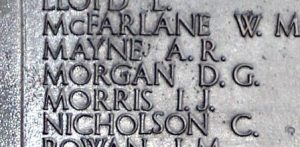
George Nolan, Sergeant, 7011654, Royal Ulster Rifles. George was born in County Antrim, Ireland. He married Elizabeth Jane Lewis, a domestic servant, of 2, Hall Street, Carmarthen at Carmarthen in the Autumn of 1941. George was probably already in the army when he married Elizabeth. He served with the 1st (Airborne) Battalion, Royal Ulster Rifles, which was attached to 6 Airlanding Brigade, 6th Airborne Division. The battalion landed around Ranville on D-Day, 6 June 1944, and captured the village of Longueval. It took part in the fighting in Normandy, before returning to England in September. It then moved back to the front to take part in the defence around the Ardennes, following the Battle of the Bulge. George was killed on 24 March 1945 when the battalion took part in a landing near Hamminkeln, where it was tasked with the capture of the bridge over the River Issel, and to secure the Ringenberg Railway Station. He was buried in Reichswald Forest War Cemetery, Germany.
David Henry Brynmor Norman, Sergeant, 1422929, Royal Air Force Volunteer Reserve. David was born in 1923, the son of Charles Thomas Norman and May Norman (nee Williams), of 4, Merlin Street, Carmarthen. He enlisted into the Royal Air Force Volunteer Reserve and trained as an Air Gunner before being posted to 178 Squadron, Royal Air Force. The Squadron was equipped with Liberators at Shandur, Egypt on 15 January 1943 and then moved to Libya. In March 1944 the Squadron, equipped with the B-24 Liberator VI, became based at RAF Amendola, in Italy and was involved in the air drop operations in support of the besieged Polish Home Army in Warsaw in 1944.On 8 January 1945 David took off from Amendola aboard a Consolidated B-24 Liberator VI, Serial KG928, on a Special Operation supply drop to partisans near Ljubljana, in Yugoslavia. The Liberator crashed in Serbia in poor weather conditions, killing all eight men aboard, including David. The 21-year-old was buried besides his comrades in Belgrade War Cemetery, Serbia & Montenegro. His brother William Christopher Norman was killed in 1944.
William Christopher Norman, Lance Corporal, 2047691, Royal Engineers. William was the son of Charles Thomas Norman and May Norman, of Carmarthen. He married Blanche White at Carmarthen in 1941. William enlisted into the Royal Engineers and was posted to the 11th Field Company, Royal Engineers and moved to Normandy at some time following D-Day, on 6 June 1944. William was badly wounded in Normandy on 17 August 1944 and died of his wounds on that same day. The 23-year-old was originally buried to the east of the village of Proussy, together with two comrades, but in April 1946 their graves were exhumed and the men were re-interred in Tilly-sur-Seulles War Cemetery. His brother David Henry Brynmor Norman was killed the following year.
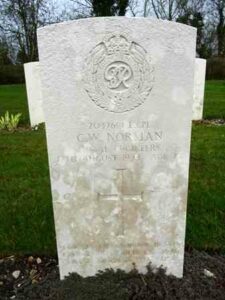
James Anthony Rourke O’Flynne, Captain, 109068, Royal Ulster Rifles. James was the son of Dennis and Harriett O’Flynn. He married Teresa Carmen O’Halloran in London in the Autumn of 1939. James originally enlisted into the Honorable Artillery Company, before being commissioned as Second Lieutenant into the Royal Ulster Rifles in December 1939, then after becoming promoted to Captain was posted to India, where he was attached to the 4th Prince of Wales’ Own Gurkha Rifles. James was killed during an accident in India on 3 May 1944, aged 31. He is buried in Madras War Cemetery, Chennai, India. His widow Teresa gave her home address as Carmarthen, but no trace of her there has presently been traced.
Thomas Brian Owen, Sergeant, 1162333, Royal Air Force Volunteer Reserve. Thomas was born in Laugharne on 31 October 1920, the son of William Owen and Annie Owen (nee Thomas). The family later resided in Ystrad, Carmarthen. Thomas was a Sergeant in the Royal Air Force Volunteer Reserve during the war, and remained in the services after the surrender of Germany and Japan in 1945, being posted to No. 5 School of Technical Training at RAF St. Athan. Thomas contracted tuberculosis during his time there and died at the RAF Hospital at St. Athan on 30 May 1947. The remains of the 26-year-old were brought home and he was buried in the new graveyard at St. Martin’s church, Laugharne.
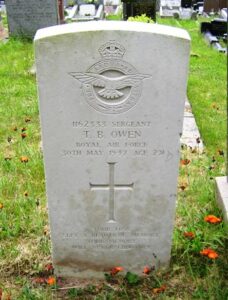
David Gareth Rees, Sergeant (Flight Engineer), 1653285, Royal Air Force Volunteer Reserve. David was born in 1924, the son of Tudor Rees and Elizabeth Rees (nee Davies), of 1, Babell Road, Pensarn, Carmarthen. He enlisted into the Royal Air Force Volunteer Reserve and after completing his training as a Flight Engineer was posted to 166 Squadron, Royal Air Force, a Bomber Command Squadron which flew the Avro Lancaster, based at RAF Kirmington. On the night of 22 October 1943, David took off from Kirmington aboard an Avro Lancaster III, Serial ED366, which joined a large bomber group despatched to strike targets in Kassel, Germany. David was killed, together with five fellow crewmen, when their Lancaster was shot down and crashed at Obermeiser, southeast of Warburg, that night. David was 22 years old when he was killed that night and was buried together with his fellow crewmen in a communal grave in Westuffeln Civil Cemetery. In June 1947 the men’s graves were exhumed and they were re-interred in Hanover War Cemetery, Germany.
Dewi Rees, First Radio Officer, Merchant Navy. Dewi was born at Porth on 15 January 1912, the son of P. E. Rees. The family later moved to Carmarthen. Dewi left home as a young man to join the Merchant Navy and trained as a Wireless Operator. He married Elizabeth Evans in Yorkshire in 1935 and by 1939 the couple were residing at 26, Moreton Road, Grimsby. Following the outbreak of war Dewi was posted aboard the Belfast registered MV Fort Richepanse, which had been requisitioned from the French following their surrender in May 1940. Elizabeth then moved to Portfield, Haverfordwest. In August 1941 Fort Richepanse departed from Montreal for Liverpool, carrying a cargo of almost 3,000 tons of general goods. During the evening of 3 September 1941 Fort Richepanse, sailing without an escort, was torpedoed and sunk by the German submarine U-567 about 450 miles southwest of Bloody Foreland, sinking with the loss of 36 lives. Dewi was 29 years old when he died that day, and is commemorated on the Tower Hill Memorial, London.
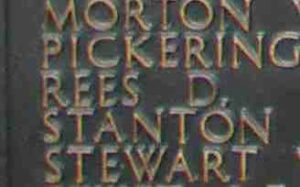
Mydrim Richards, Able Seaman, D/JX 195019, Royal Navy. Mydrim was born at Garnant on 29 April 1920, the son of Joseph Richards and Annie Richards (nee Hopkins). The family came to live at 70, Priory Street, Carmarthen soon afterwards. Mydrim worked as a clerk in a Motor Garage prior to enlisting into the Royal Navy and was posted aboard the Halcyon Class Minesweeper HMS Bramble. She served on the Russian Convoys, providing minesweeping cover for the merchant vessels bringing supplies to Russia. On 22 December 1942 Bramble sailed with Convoy JW 51B from Loch Ewe. The convoy was sighted by the German submarine U-354 on 30 December and the German cruisers Admiral Hipper and Lützow, accompanied by six destroyers, sailed from Altenfjord to intercept them in an action later named the Battle of the Barents Sea. On 31 December 1942, Bramble, which had been detached to search for stragglers, was returning to the convoy when she encountered Admiral Hipper and three destroyers. Hipper promptly opened fire with her main guns and badly damaged her, before she was sunk with all hands by one of the German escort destroyers. Mydrim was 22 years old when he died that day, and is commemorated on the Plymouth Naval Memorial, Devon.
Gilbert Humphreys Rogers, Sergeant, 1382746, Royal Air Force Volunteer Reserve. Gilbert wwas born on 3 May 1915, the son of Herbert Rogers and Margaret Rogers (nee Humphreys), of 3, Plasbach, Reservoir Road, Carmarthen. He was a Postman at Carmarthen prior to enlisting into the Royal Air Force Volunteer Reserve and after completing is training as an Air Gunner was posted to 75 (New Zealand) Squadron, Royal Air Force. The squadron was a heavy bomber unit, crewed mainly by New Zealanders, and was equipped with the Short Stirling, based at RAF Newmarket Heath. Gilbert was killed when his Stirling, Serial EF340, Identifier AA-Q, was lost mine whilst on mine laying duties in the Nectarine region off the Friesian Islands on 5 May 1943. The 27-year-old has no known grave, so is commemorated on the Runnymede Memorial, Surrey. An elder brother, Thomas Humphrey Rogers, was killed in France in 1918, during the Great War.
Thomas Emrys Royce, Petty Officer Stoker, D/KX 77859, Royal Navy. Thomas was born at Pentre, Rhondda on 1 September 1908, the son of Thomas Royce, and of Elizabeth Royce. His mother hailed from Llangain, so at some time after Thomas’s birth the family returned to west Wales and came to live at Brynteg, Travellers Rest, Carmarthen. Thomas worked as an ironmonger’s delivery boy prior to enlisting into the Royal Navy on 8 March 1927 and trained at HMS Vivid II. By the time war erupted, Thomas was serving aboard HMS Drake, an ancient WW1 period River Monitor, which served as a Stoker Training Ship at Plymouth. Thomas died on active service at Plymouth on 21 April 1941. The 32-year-old is buried in Plymouth (Weston Mill) Cemetery, Devon.
Douglas James Saunders, Gunner, 3962008, Royal Artillery. Douglas was born in 1920, the son of James Oswald Saunders and Minna Saunders (nee Davies), of 2, Furnace Road, Carmarthen. He enlisted into the Royal Artillery and was posted to the 31st Field Regiment, Royal Artillery. The regiment had been in Egypt when war erupted, and in June 1940 joined the 4th Indian Division, before taking part in the Western Desert campaign. Douglas was among a number of men of his battery killed on 15 December 1941, during heavy fighting at Point 204, near Alem Hamza, Cyrenaica. The 22-year-old has no known grave, so is commemorated on the Alamein Memorial, Egypt.
Charles Edward Scott, Private, 5671975, Parachute Regiment. Charles was born in 1923, the son of Victor Charles Scott and Irene Blodwen Scott (nee Williams), of Carmarthen. The family later left Carmarthen and moved to Highbridge, Somerset. Charles enlisted into the army and was posted to the 6th Battalion, Parachute Regiment, which had been formed from the 10th Battalion, The Royal Welch Fusiliers in 1942, joining the 2nd Parachute Brigade, 1st Airborne Division. The battalion’s first action was during Operation Slapstick, one of three British Landings during the Allied invasion of Italy in September 1943, when it was ordered to land at the port of Taranto. The 2nd Parachute Brigade left Bizerta on 8 September, the day before the Italian surrender, and landed unopposed, however Charles was among fifty-eight men from the 6th Parachute Battalion who drowned after their transport ship HMS Abdiel hit a mine in the harbour and sank on 10 September 1943. The 21-year-old has no known grave, so is commemorated on the Cassino Memorial, Italy.
Ceiriog Josue Henri Sebire, Private, 14406335, Parachute Regiment. Ceiriog, known as Jose, was born on 26 April 1924, the son of Sydney Harold Sebire and Olwen Myrddin Sebire (nee Davies), of 5, Waterloo Terrace, Carmarthen. His father had served as a Congregational Minister in the town for several years, but upon retiring moved to Holloway, London. Jose enlisted into the army and was posted to the 9th Battalion, Parachute Regiment. He dropped into Normandy on D-Day, 6 June 1944, and took part in the operations around Ranville and the destruction of the Merville Battery. Jose was killed in Normandy on 24 July 1944. The 20-year-old was buried in Ranville War Cemetery, France.
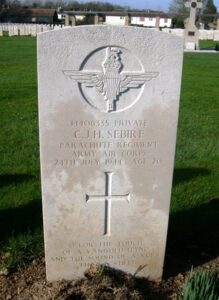
William James Sivyer, Stoker 1st Class, D/309223, Royal Navy. William was born at Pembroke Dock on 14 November 1887, the son of William James Sivyer and Martha Ann Sivyer. His father died when he was young, so William was raised by his grandparents, William and Mary Griffiths. William was also a regular visitor to his Aunt, Margaret Smith, at Carmarthen. He had served during WW1, and again during WW2 as a Stoker in the Royal Navy, and during the Second World War served at HMS Lucifer, the Royal Naval base at Swansea. William took ill around Christmas time, 1944 and died of emphysema and cardiac failure at the Royal Naval Sick Quarters in Swansea on 1 January 1945. The 57-year-old was buried in Morriston Cemetery, Swansea.
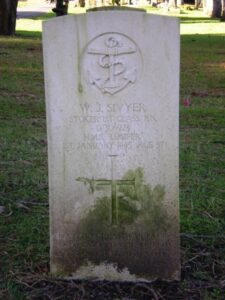
Bruce Leighton Squires, Trooper, 7945575, Royal Armoured Corps. Bruce was born in 1921. the son of Charles Percy Squires and Edith Maud Squires (nee Howe), of 21, Parcyrafon Road, Carmarthen. Bruce was educated at Carmarthen Grammar School before enlisting into the army and was posted to “C” Squadron, North Irish Horse, which was attached to the Royal Armoured Corps. On 2 February 1943 the North Irish Horse landed in Algiers, as part of Operation Torch, equipped with the Churchill tank. After a trying campaign in Tunisia it re-equipped with the Sherman Tank before moving to take part in the Italian campaign. Bruce was posted as missing believed killed in action on 23 May 1944 during a bloody assault on the Adolf Hitler Line, which saw the North Irish Horse suffer terrible casualties. The body of the 23-year-old was recovered soon afterwards and he was buried on the battlefield. In February 1945 his grave, together with several other scattered burials, was exhumed and re-interred in Cassino War Cemetery, Italy.
Gerald Alec Stewart-Rattray, Captain, 66756, Royal Army Service Corps. Gerald was born on 21 November 1916, the son of James Alec Rattray and Violet May Rattray (nee Hill), of Plymouth. His father, a Second Lieutenant with the Royal Garrison Artillery, was killed at Ypres in 1917 and the following year his mother remarried to Robert Surcombe, who had been a Gunner with the Royal Garrison Artillery. Gerald married Ada Ernestine Willis in Plymouth in 1937. Gerald was commissioned as an officer into the Royal Army Service Corps, and had served in France with the 70th Infantry Brigade in 1940, being evacuated from Dunkirk. The Brigade then spent the next two years in England, training for overseas service again. Gerald died at Carmarthen on 18 May 1943. The 26-year-old was buried in Carmarthen Cemetery. His widow, Ada, married again and died in 2000.
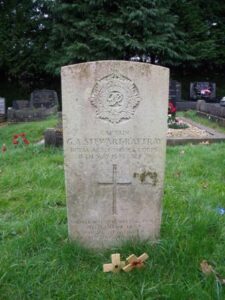
George David Thacker, Lieutenant, 131438, Royal Electrical and Mechanical Engineers. George was born on 10 August 1890, the son of George Thacker and Susan Thacker (nee Sharp), of North Lodge, Orielton, Hundleton. George left home as a young man to work for the Great Western Railway, and worked as a cleaner at Llanelly and Llandovery Stations. His father worked as a Butler and by 1911 the family had moved to Roedean, Alan Road, Llandeilo. By then George had found work as a colliery repairer. George had served during the Greaat War with the Army Service Corps, where he must have trained as a Motor Mechanic. He married Lettice Williams, of Llandeilo, at St. Jude’s Church, Swansea on 9 April 1929 and the couple moved to 16, St. Catherine Street, Carmarthen, where George had gained work as a Motor Engineer. He enlisted into the Royal Electrical and Mechanical Engineers, and was commissioned as an officer in May 1940 before being posted to Egypt to take part in the North African campaign. George became ill and died in North Africa on 25 February 1943. The 52-year-old is buried in Heliopolis War Cemetery, Egypt. His widow, Lettice, never remarried and died in Carmarthen in 1971.
Adolphus Stephens Thomas, Guardsman, 2734529, Welsh Guards. Adolphus was born in 1923, the son of John Nicholas Thomas and Nina Harris Thomas (nee Stephens), of 11, Prospect Place, Carmarthen. He enlisted into the army and was posted to the 3rd Battalion, Welsh Guards, which had formed at Beavers Camp, Hounslow on 24 October 1941. The Battalion sailed for North Africa on 5 February 1943, landing in Algiers three days later then after a long march moved by trucks to El Aroussa, twenty miles south of Medjez El Bab, joining the 1st Guards Brigade. The 3rd Welsh Guards then joined the offensive to capture the rugged hills on either side of Fondouk Gap, which was successfully taken. The battalion saw further action near the town of Hammam Lif on 8 May 1943, but soon afterwards the Afrika Korps surrendered and attention turned to Italy. Early in 1944 the 3rd Welsh Guards moved to Italy, and by 9 February 1944 held positions on the slopes of Monte Furlito. The battalion was then ordered to relieve the 2nd/4th Hampshire Regiment, with orders to hold Monte Cerasola, which had just been captured. Adolphus was killed here on 16 February 1944. The 19-year-old was originally buried in an isolated battlefield cemetery, but in June 1945 his grave was exhumed and he was re-interred in Cassino War Cemetery, Italy.
Albert John Thomas, Private, 3963308, East Yorkshire Regiment. Albert was born on 30 June 1920, the son of Sidney George Thomas and Agnes Mary Thomas (nee Ruffles), of 2, Quay Street Bank, Carmarthen. He enlisted into the army and was posted to the 5th Battalion, East Yorkshire Regiment. The Battalion was formed in June 1939 as a 2nd Line Territorial Army duplicate of the 4th Battalion, joining the 69th Infantry Brigade, 23rd (Northumbrian) Division and was evacuated from Dunkirk. It later served with 50th (Northumbrian) Division through the Western Desert, Tunisian and Sicily campaigns before landing in the first wave on Gold Beach on D-Day and then fighting during the break-out from Normandy and the subsequent drive through Northern France into Belgium and Holland. The 50th Division then took part in Operation Market Garden, the audacious plan to cross the Rhine into Germany, moving forward and joining the fighting on 17 September. Albert was wounded during heavy fighting in the Nijmegen Salient on 25 September 1944 and died of his wounds two days later, on 27 September 1944. The 24-year-old was originally buried in Marienbosch Cemetery, but April 1947 the war graves within the cemetery were exhumed and re-interred in Jonkerbos War Cemetery, Gelderland, Netherlands. His brother, Vincent George Thomas, was killed in Belgium less than two weeks later.
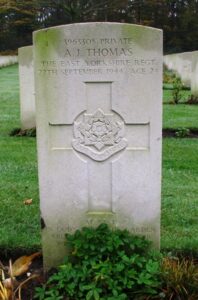
Daniel David Thomas, Sergeant, 2031229, Royal Engineers. Daniel was born in 1911, the son of John Rees Thomas and Elizabeth Thomas. He married Elizabeth Doreen Gilligan in Carmarthen in 1937 and the couple set up home at 97, Lammas Street, Carmarthen. Daniel enlisted into the Royal Engineers soon after the outbreak of war and in January 1941 was posted to the Mediterranean with 580 Army Troops Company, Royal Engineers, disembarking at Port Tewfik on the Suez Canal 4 March. In March 1941, troops were sent to Greece to assist the Greek Army against a probable German invasion. The bulk of the front-line forces were Australian, New Zealand and Polish troops, but they were supported by British armour and a number of RE works and transportation units including the newly arrived 580th Army Troops Company, which had been tasked with repairing and improving the rudimentary road and rail network of the Greek mainland, as well as preparing demolitions to delay the enemy advance. The German attack came on 5 April, before the Commonwealth troops were fully in position, and the Allied forces were soon in retreat. On 19 April troops began to be evacuated from the port of Piraeus, whilst delaying actions were fought in the passes leading to the town. A large steam yacht, the Hellas, came into the harbour on 24 April and took aboard a large number of civilians and soldiers, including the men of 580 Army Troops Company. Tragically as the ship was about to sail out of Piraeus it was attacked by German Junkers 87 Stuka Dive-Bombers and sank with the loss of almost 500 lives. Daniel was posted as missing, presumed killed in action on 25 April 1941, becoming the second Carmarthenshire man of the unit to lose his life in Greece. The 29-year-old has no known grave, so is commemorated on Face 4 of the Athens Memorial, Greece.
David John Dudley Thomas, Sergeant, Royal Air Force Volunteer Reserve. David was born on 13 April 1922, the son of Mansel Thomas and Elizabeth Thomas (nee Phillips), of Porthyrhyd, Tanerdy, Carmarthen. He worked as a painter with his father prior to enlisting into the Royal Air Force Volunteer Reserve and after completing his training as a Wireless Operator/ Air Gunner, was posted to 226 Squadron, Royal Air Force, a medium bomber squadron which flew the Douglas Boston IIIA, based at Swanton Morley. On 25 January 1943 David took off from Swanton Morley aboard a Douglas Boston III, Serial W8354, which joined a number of other aircraft despatched to strike targets in Flushing Docks, in Vlissingen. David and his three fellow crewmen were killed when their Boston was hit by Naval flak and crashed near Vlissingen Airfield. The 20-year-old was buried besides his fellow crewmen in Flushing (Vlissingen) Northern Cemetery, Netherlands.
David Lynam Thomas, Trooper, 7945206, Royal Armoured Corps. David was born in Jubbulpore, Bengal in 1922, the son of Gwilym Thomas and Blodwen Thomas (nee Phillips). Upon leaving the army his father returned to Wales with the family and settled in Carmarthen, where David was educated. He enlisted into the army and was posted to India to join the 26th Hussars, Royal Armoured Corps. The regiment was raised at Meerut in June 1941 from a cadre of personnel taken from the 14th/20th King’s Hussars, and was assigned to 2nd Indian Armoured Brigade, equipped with American Stuart and Grant tanks. David died at Nira Camp, near Poona, on 3 June 1942, aged 20. He is buried in Kirkee War Cemetery, India. His father died in Carmarthen in 1936 and his mother moved to Llanishen, Cardiff.
David Scurlock Thomas, Guardsman, 2737489, Welsh Guards. David was born on 17 July 1920, the son of Niah Thomas and Letitia Thomas (nee Davies), of 50c, Priory Street, Carmarthen. He worked as a Shop Assistant prior to enlisting into the Welsh Guards and married Eleanor Louise Morgan, of 23, Heol Spurrell, Carmarthen, whilst on leave on 2 November 1940. David was posted to the 3rd Battalion, Welsh Guards, which had formed at Beavers Camp, Hounslow on 24 October 1941. The Battalion sailed for North Africa on 5 February 1943, landing in Algiers three days later then after a long march moved by trucks to El Aroussa, twenty miles south of Medjez El Bab, joining the 1st Guards Brigade. The 3rd Welsh Guards then joined the offensive to capture the rugged hills on either side of Fondouk Gap. The 1st Guards Brigade was to capture the hills to the North of the Gap, with the 3rd Welsh Guards to carry out the opening assault. On the night of 8 April 1943 Battalion HQ and all companies except Number One Company were dug in near the higher ground west of the river bend, Number One Company was across the river on a knoll, acting as the advance-guard to the Battalion. The following morning, 9 April 1943, the battalion Stood To, then advanced and attacked the El Rhorab feature. The Battalion soon came under heavy machine gun and mortar fire, but reached its objectives and the enemy holding the position surrendered. Casualties had been heavy though, with nine Officers and 105 other ranks killed or wounded. David had been killed in action during he assault that day. The 32-year-old was originally buried together with many of his fallen comrades on the battlefield, but in February 1944 their graves were exhumed and the men were re-interred in Enfidaville War Cemetery, Tunisia.
Herbert William Thomas, Gunner, 1485314, Royal Artillery. Herbert was born in Swansea on 11 August 1915, the only child of Charles Samuel Thomas and Winifred Ellen Thomas. His mother had been raised in Abergwili and had then lived with her parents in the Red Lion Inn at 2, Priory Street, Carmarthen prior to being married. Herbert’s father was a well-known Architect and Surveyor, and served as a Captain in the 4th Battalion, Welsh Regiment, the local Territorial Army battalion, and his mother was a district nurse. Herbert was baptised in Carmarthen, in St. Peter’s Church, on 19 September 1915. By 1939 Herbert’s parents had both died and he was residing at Rhyddings House, Brynmill. He had enlisted into the Royal Artillery prior to the war and was a serving member of the 64th Battery, 34th Light Anti Aircraft Regiment, Royal Artillery, which was attached to Western Command at Swansea. Herbert was mobilised when war erupted, and soon after the start of the Blitz was transferred to Plymouth. Herbert appears to have been killed during a terrible air raid on Plymouth on 21 April 1941. The 25-year-old is buried in Plymouth (Weston Mill) Cemetery. Probate was granted to his uncle, George Luther Thomas, at Carmarthen.
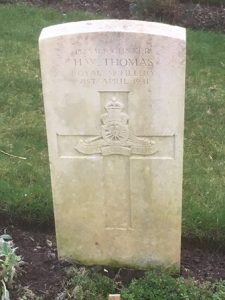
Horace Samuel Thomas, Lance Corporal, 80466, Straits Settlements Volunteer Force. Horace was born on 15 June 1916, the son of John Thomas and Mary Thomas, of Brynawellon, Millbank Crescent, Carmarthen. He was living in Malacca when war broke out and volunteered to serve with the 4th (Malacca Volunteer Corps) Battalion, Straits Settlement Force, which was a volunteer force, stationed in Malacca. Horace was taken POW by the Japanese after the invasion of Singapore in December 1941. He was held at Changi Jail until 4 September 1944, when he sailed from Singapore in the Hell Ship Rakuyo Maru, which was crammed with POW’s bound for Japan, to be used for slave labour. On 12 September 1944 the ship was torpedoed and sunk by the American Submarine USS Sealion, with the loss of 1,159 POW’s. Horace was 27 years old when he lost his life that day and is commemorated on the Singapore Memorial, Singapore.
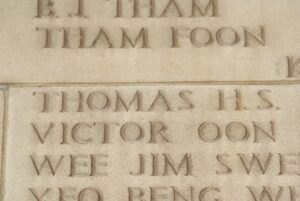
Melville Elvet Thomas, Aircraftman 1st Class, 1312270, Royal Air Force Volunteer Reserve. Melville was born on 30 September 1920, the son of David Thomas and Annie Thomas (nee Jones), of Towy Cottage, Llangunnor. He worked as a coach body builder prior to enlisting into the Royal Air Force Volunteer Reserve and was posted to RAF Technical Command at RAF Tangmere. Melville was asleep in his barracks at Shepperton during the early hours of 23 February 1944 when a German HE bomb was dropped and brought the building down on him. His body was recovered from the ruins, and the remains of the 23-year-old were conveyed home and buried in St. Cynwyr’s Churchyard, Llangunnor on 28 February.
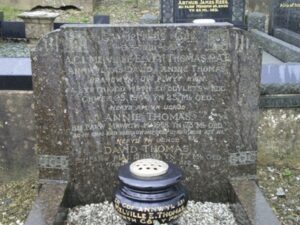
Stephen George Thomas, Flight Sergeant, 1314103, Royal Air Force Volunteer Reserve. Stephen was born on 27 September 1922, the son of Stephen Lewis Thomas and Helen Josephine Thomas (nee Murphy), of 1, Friars Row, Carmarthen. He enlisted into the Royal Air Force Volunteer Reserve and after completing his training was posted to 14 Squadron, Royal Air Force, which was equipped with the Martin B-26 Marauder, medium bomber. After the Allied invasion of Italy, 14 Squadron moved to Ghisonaccia, on the island of Corsica to carry out strategic bombing missions over mainland Italy. On 15 December 1943 Stephen took off from Ghisonaccia aboard a Martin Marauder I, Serial FK127, on a low flying navigational exercise. The aircraft went missing, believed to have crashed into the sea off the Algerian coast, with the loss of all six of her crew. Stephen was 21 years old, and is commemorated on the Malta Memorial, Malta.
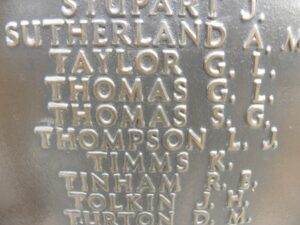
Vincent George Thomas, Private, 3963260, Welch Regiment. Vincent was born on 18 May 1918, the son of Sidney George Thomas and Agnes May Thomas (nee Ruffles), of 2, Quay Street Bank, Carmarthen. He enlisted into the army and was posted to the 4th Battalion, Welch Regiment, which was the local Territorial unit, attached to 158 Brigade, 53rd (Welsh) Division. The battalion was mobilised at the outbreak of war, when the Division moved to Northern Ireland to begin garrison duties. The Division then moved to Pembroke Dock, before moving again to the south of England, where it trained in readiness for the D-Day Landings. On 18 June 1944 the 4th Welch left England for Normandy, and entered the Seine Bay, before disembarking and moving to the Odon Bridgehead to relieve the 9th Cameronians. The Division then took part in heavy fighting over the coming weeks, as part of the effort to break-out of the Normandy beach-head, seeing heavy fighting at Le Bon Repos, before starting the epic advance through Northern France into Belgium and Holland. On 15 September the Division forced the crossing of the Junction Canal North of Lommel, and continued to push westwards towards Elst, between Nijmegen and Arnhem, during Operation Market Garden. The 4th Welch made a successful attack on a wood at Wilreit on 18 September, before advancing further and occupying Postel within a week, reaching Reusel. Bitter street fighting then raged for Reusel over the coming days, before the town was cleared and the 53rd Division moved to defensive positions between Nijmegen and Arnhem. On 6 October the 4th Welch moved through Lieshout to Ousterhout, relieving the 5th Coldstream Guards and began sending out patrols. Vincent was posted as missing, believed killed in action here on 9 October 1944. No trace of the 26-year-old was ever found, so he is commemorated on the Groesbeek Memorial, Gelderland, Netherlands. His brother, Albert John Thomas, had been killed in Holland just two weeks earlier.
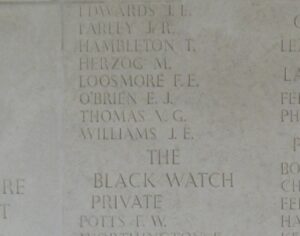
William Thomas, Private, 3960949, South Wales Borderers. William was born in Carmarthen in 1918. He had originally enlisted into the Welch Regiment, but later transferred to the 6th Battalion, South Wales Borderers which sailed for Bombay in October 1942. The battalion had trained to serve as an armoured unit but was disappointed to find that upon arrival in India it was to revert to infantry. It then trained as an amphibious assault unit and moved to Calcutta to attack Akyab. The attack was soon cancelled and the battalion was sent to Burma to fight in the Arakan. It made its name during heavy fighting which resulted in the capture of the Mayu Tunnels. The battalion was then sent to join the joint American-Chinese force under General Stilwell and took part in an epic nine month march through the Burmese jungle which saw them take place in several bloody engagements against the Japanese. William was killed in action in Burma on 13 January 1945, aged 26. He is buried in Taukkyan War Cemetery.
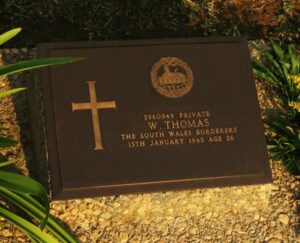
William Geoffrey Thomas, Third Radio Officer, Merchant Navy. William was born in 1922, the son of Mrs. Muriel Thomas, of 2, Guildhall Square, Carmarthen. Upon leaving Carmarthen Grammar School he enlisted into the Merchant Navy and after training to become a Radio Officer was posted aboard the Swansea registered cargo steamer SS Tunisia. On 4 August 1941 Tunisia was about 350 miles off Ireland, carrying a cargo of manganese ore, when she was bombed by German FW200 aircraft and sank about 350 miles West of Achill Head, Co. Mayo, going down with the lives of 36 men. William was 19 years old when he died that day, and is commemorated on the Tower Hill Memorial, London.

William Glanville Thomas, Lieutenant, EC/9637, Indian Army. William was born at 41 Water Street, Kidwelly on 14 April 1922, the son of Benjamin Thomas and Sarah Thomas. The family then moved back to his mothers home town of Carmarthen, and moved into 36, Spilman Street, Carmarthen. After leaving Carmarthen Grammar School, William enlisted into the army and was commissioned as an officer into the Indian Army on 12 December 1942, before being posted to the 7th Battalion of the 9th Jat Regiment. The regiment saw much action during the war, taking part in the campaigns in North Africa, Ethiopia, Burma, Malaya, Singapore, and Java-Sumatra. William died in India on 12 September 1944. He was 22 years old and is buried in Delhi War Cemetery, India.
Harold Arthur Trumper, Ordinary Seaman, C/JX 259999, Royal Navy. Harold was born in Hereford on 17 April 1914, the son of Thomas Trumper and Ada Trumper (nee Williams). By 1925 the family had moved to 42, Parcmaen Street, Carmarthen, where Thomas worked as a coal salesman. Harold worked as a clerk prior to enlisting into the Royal Navy and was posted aboard the Flower Class Corvette HMS Zinnia. She was built at Smiths Dock Company, South Bank-on-Tees, launched on 28 November 1940 and commissioned on 30 March 1941, her sole purpose being to carry out convoy escort duties, and served in the North Atlantic. On 23 August 1941 Zinnia was escorting Convoy OG-71 and was west of Portugal when she was hit by a torpedo from the German submarine U-564, exploded and sank with the loss of some 65 lives. Harold was 27 years old when he died that day, and is commemorated on the Chatham Naval Memorial, Kent.
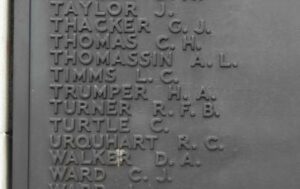
Fransisco Ullo, Fusilier, 4204910, Royal Welch Fusiliers. Fransisco was born on 15 June 1920, the son of Pasquale Ullo and Maria Ullo, of 146, Windsor Road, Neath. He was lodging at Marlborough Road, Swansea prior to the war, and was unemployed, seeking work. He then enlisted into the army and was posted to the 13th (Home Defence) Battalion, Royal Welch Fusiliers, which was a home service unit. Fransisco died as a result of an accident at Carmarthen on 21 June 1942. The 22-year-old was buried in St. Mary’s Roman Catholic Churchyard, Carmarthen.
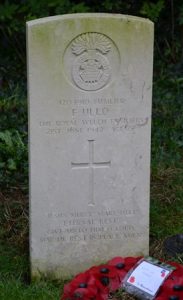
Lawrence Walters, Warrant Officer, 1316296, Royal Air Force Volunteer Reserve. Lawrence was born in 1922, the son of Rachel Eunice Walters, the daughter of William John Walters, of Ffordd, Llangain. His mother married Percy Allney Jones, of Carmarthen, in 1926 and later emigrated with him to Australia. Lawrence enlisted into the Royal Air Force Volunteer Reserve and after gaining his pilots wings was posted to the Far East to join 681 Squadron, Royal Air Force, which had been formed at Dum Dum in India in 1943, flying on coastal defensive work. The Squadron was initially equipped with the Spitfire IV, but was re-equipped with the Mosquito IX in August that year. In October it received a batch of brand new Supermarine Spitfire XI’s, and moved to Alipore in May 1944. The Squadron flew missions over the Far East throughout its time at war. Lawrence was tragically drowned during a swimming incident on 22 February 1945. The 23-year-old has no known grave, so is commemorated on the Singapore Memorial, Kranji.
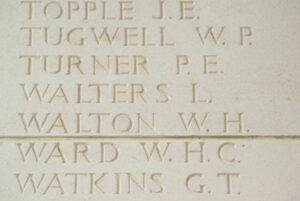
David Eric Williams, Aircraftman 2nd Class, 1047445, Royal Air Force Volunteer Reserve. David was born on 1 December 1920, the son of David Williams and Ellen Williams (nee Jones), of 16, St. Clears Road, Johnstown, Carmarthen. He worked as a Solicitor’s Clerk prior to enlisting into the Royal Air Force Volunteer Reserve and was posted to No. 1 Recruits Centre at RAF St. Athan. David became seriously ill on 16 June 1941 and was admitted to the RAF hospital at St. Athan, where he died that same day of meningitis. The body of the 20-year-old was conveyed home and he was buried in St. Luke’s Churchyard, at Llanllwch.
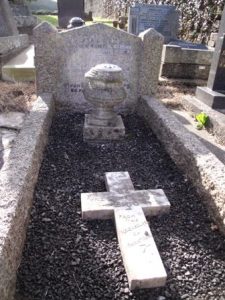
David Hywel Thomas Williams, Donkeyman, Merchant Navy. David was born on 6 April 1914, the son of Sylvanus Williams and Mary Ann Williams (nee Thomas), of Ty’ryscawen Farm, Carmarthen. He was baptised at St. Peter’s Church on 24 May 1914. David resided at The Grove, Llanegwad prior to the war, then enlisted into the Merchant Navy and was posted aboard the Liverpool registered oil tanker, MV Cordelia. On 3 February 1943 Cordelia was on route from Curacao for New York and the Clyde carrying 12,000 tons of Admiralty Fuel Oil, when she was torpedoed and sunk by the German submarine U-632. David was 28 years old when he died that day, and is commemorated on the Tower Hill Memorial, London. Probate was granted to his sister, Nancy Felix, at 17, Mansell Street, Carmarthen.

Arthur William Wynne, Trooper, 4035283, Royal Armoured Corps. Arthur was born in 1914, the son of James Wynne and Adelaide Wynne (nee Warner), of Hanmer, Flintshire. He enlisted into the army and was posted to the 53rd Regiment, Reconnaissance Corps, which was attached to the 53rd (Welsh) Division. The Division moved to Northern Ireland to begin garrison duties soon after the outbreak of war, then moved to Pembroke Dock, before moving again to the south of England, where it trained in readiness for the D-Day Landings. Arthur married Constance Nancy Gwenneth Scourfield, of Carmarthen, whilst on leave in 1940. Spending the next few years on home defence duties, during the last weeks of June 1944 the various units of the 53rd Division left England for Normandy, then took part in heavy fighting over the coming weeks, as part of the effort to break-out of the Normandy beach-head, seeing heavy fighting at Évrecy. Arthur was killed in action in Normandy on 2 August 1944. The 30-year-old was originally buried in an isolated grave near Esquay, but in July 1945 his grave was exhumed and he was re-interred in St. Manvieu War Cemetery, Cheux, France.
